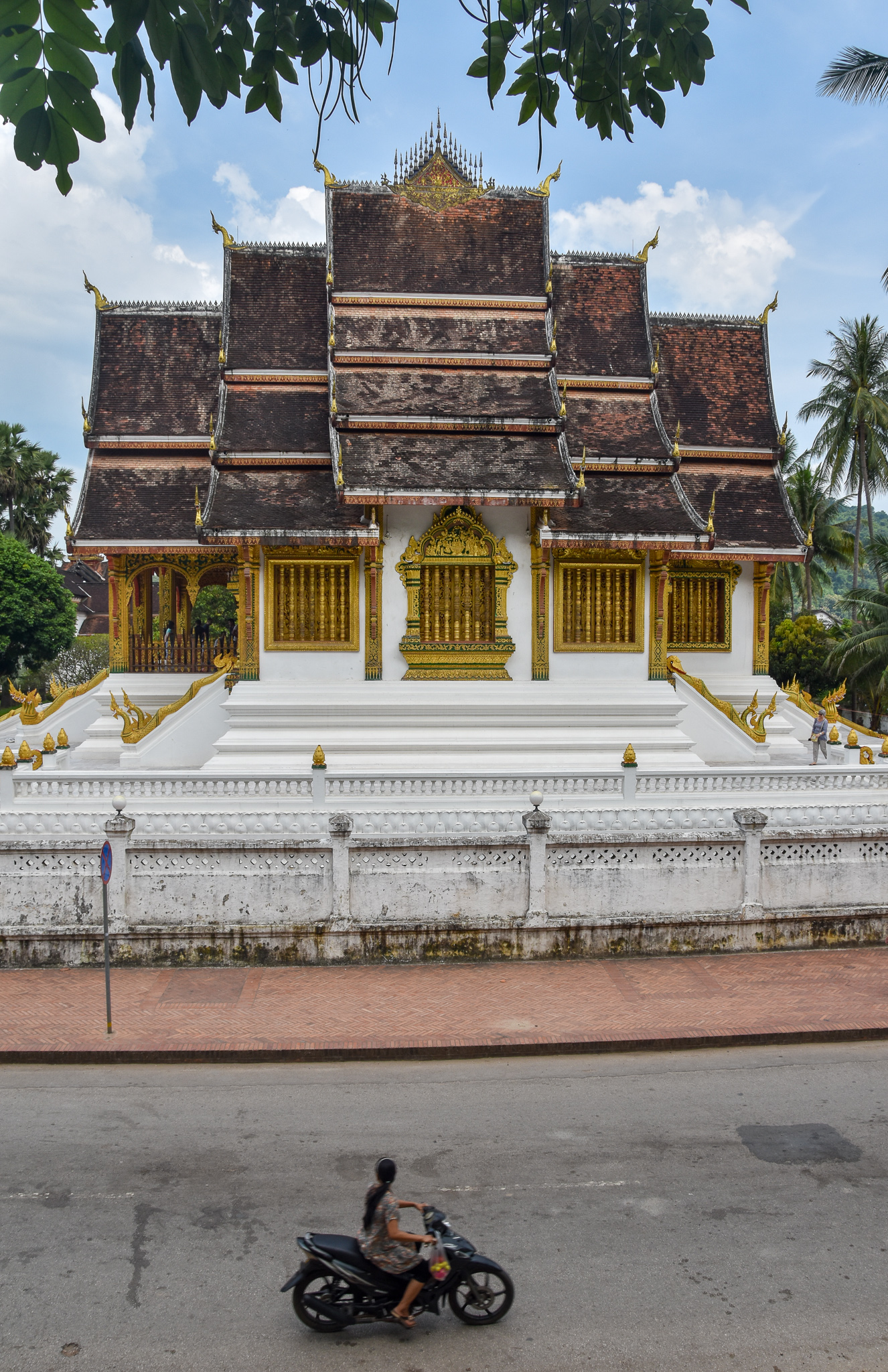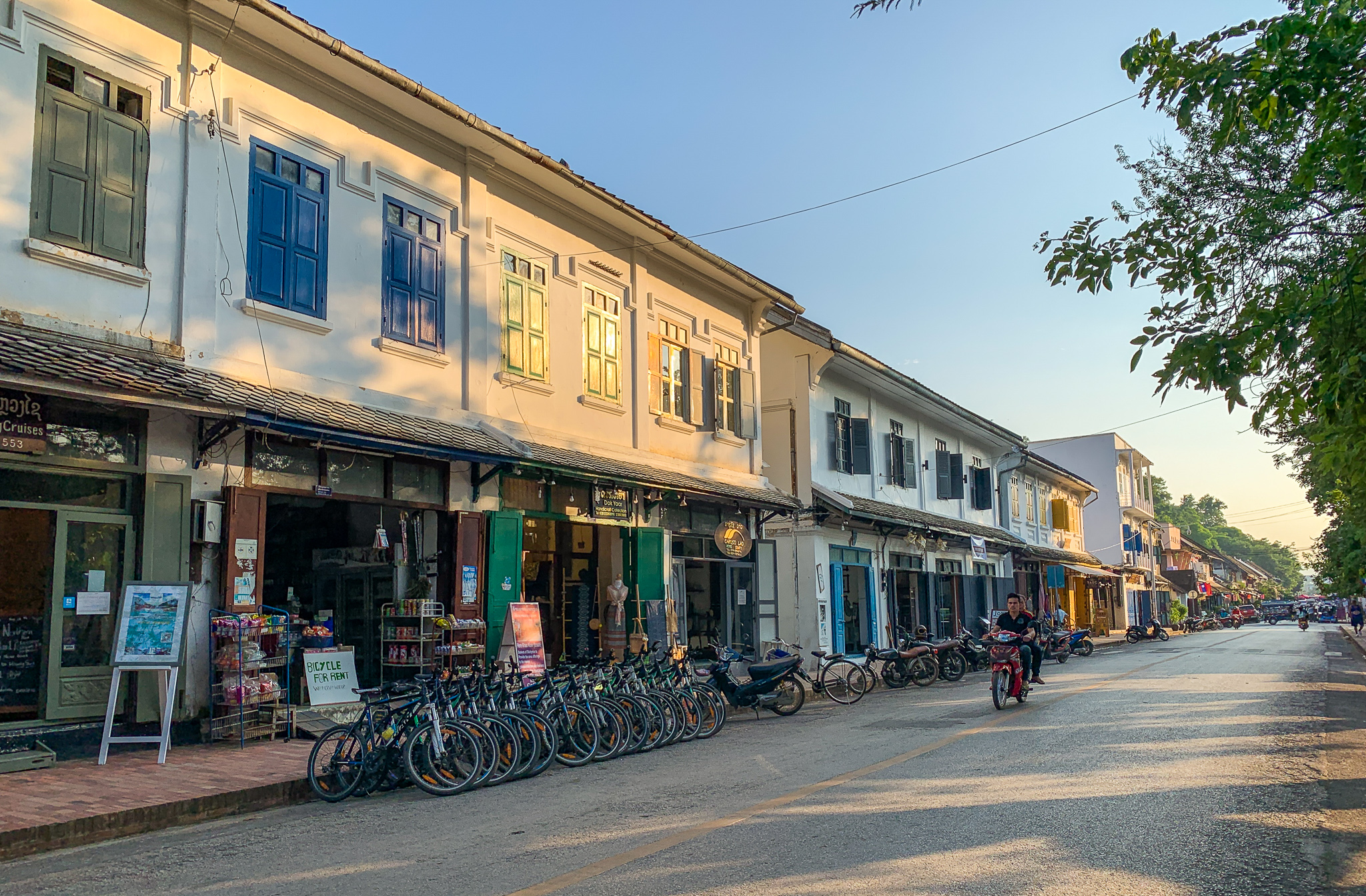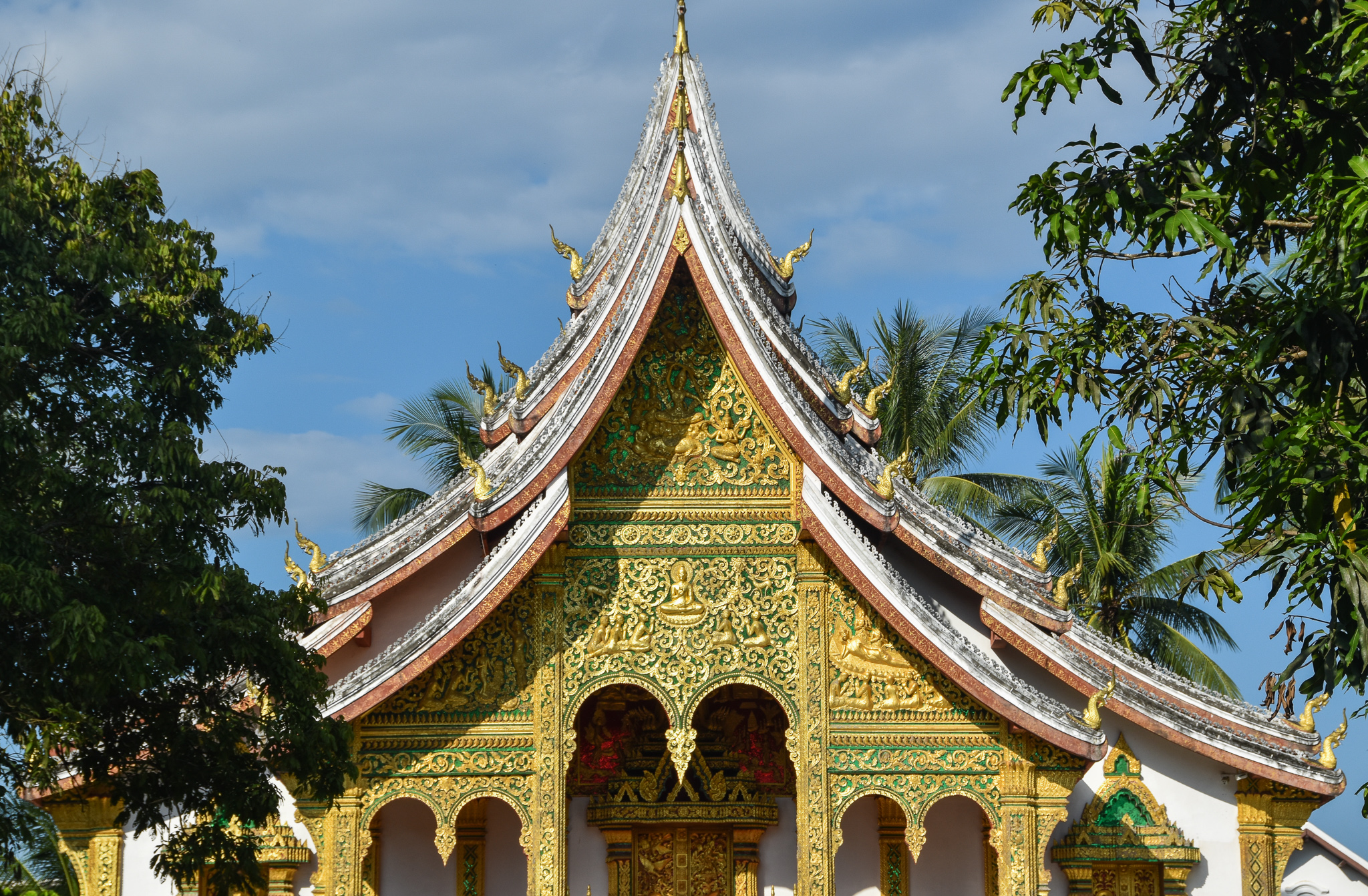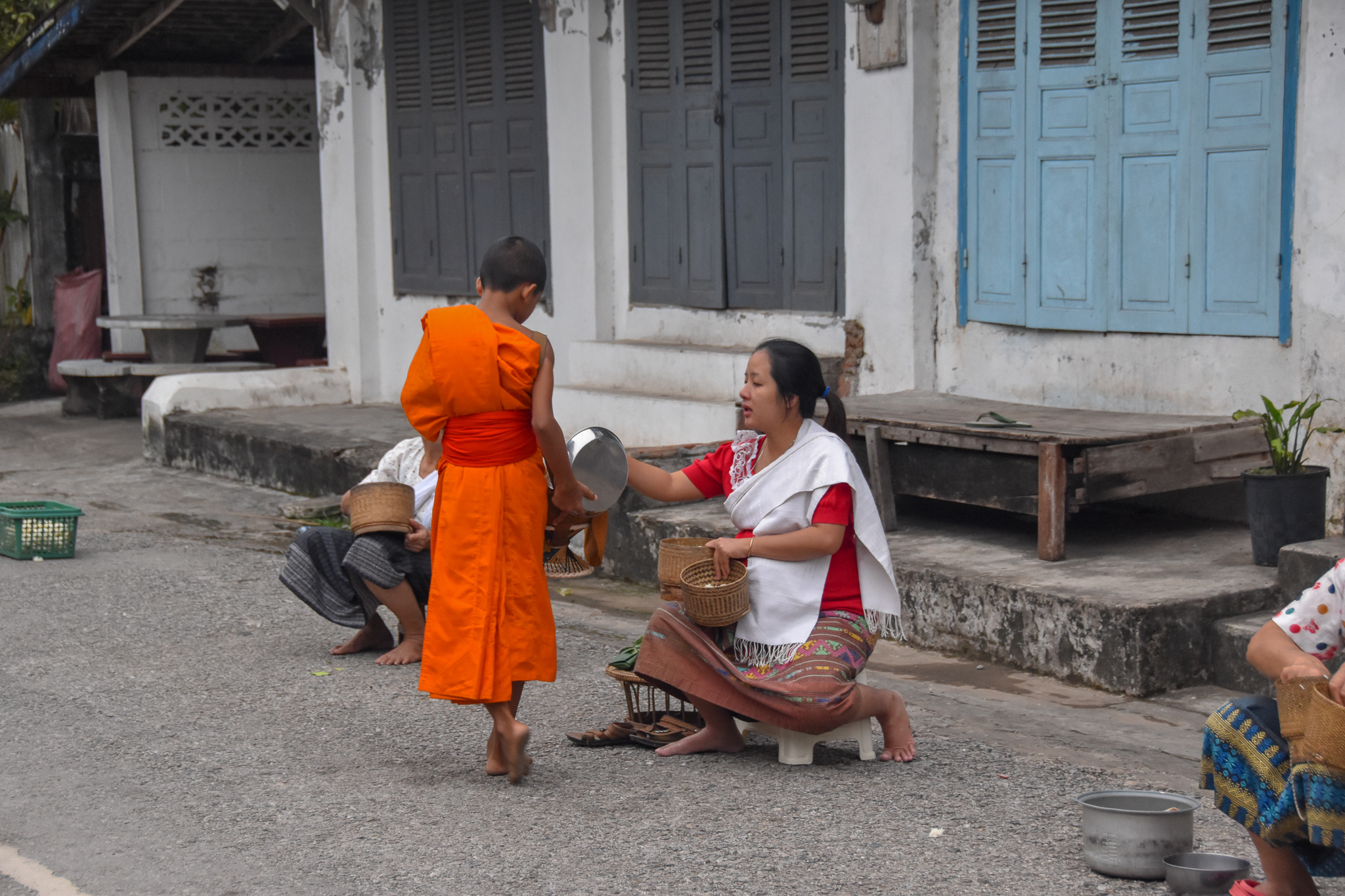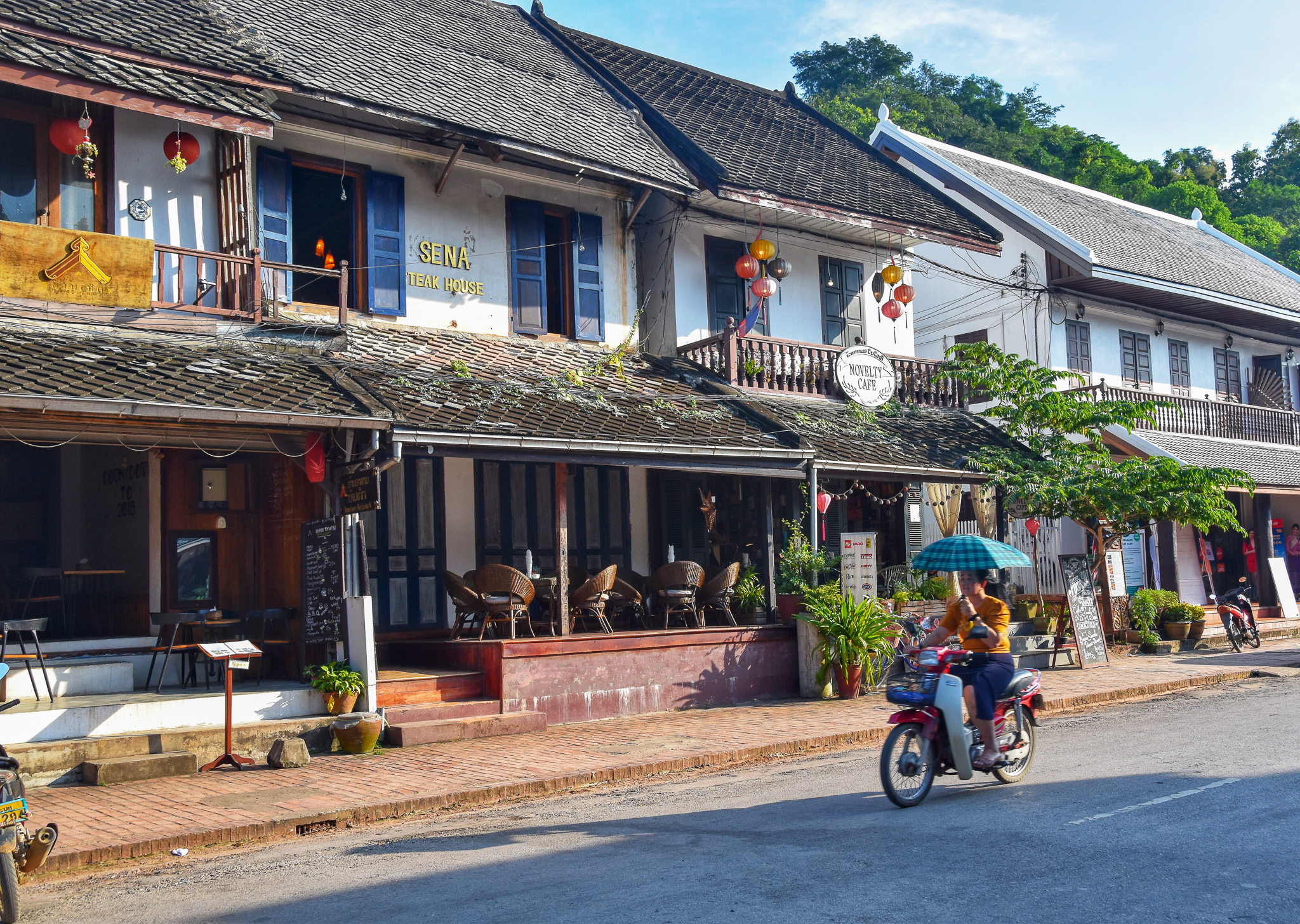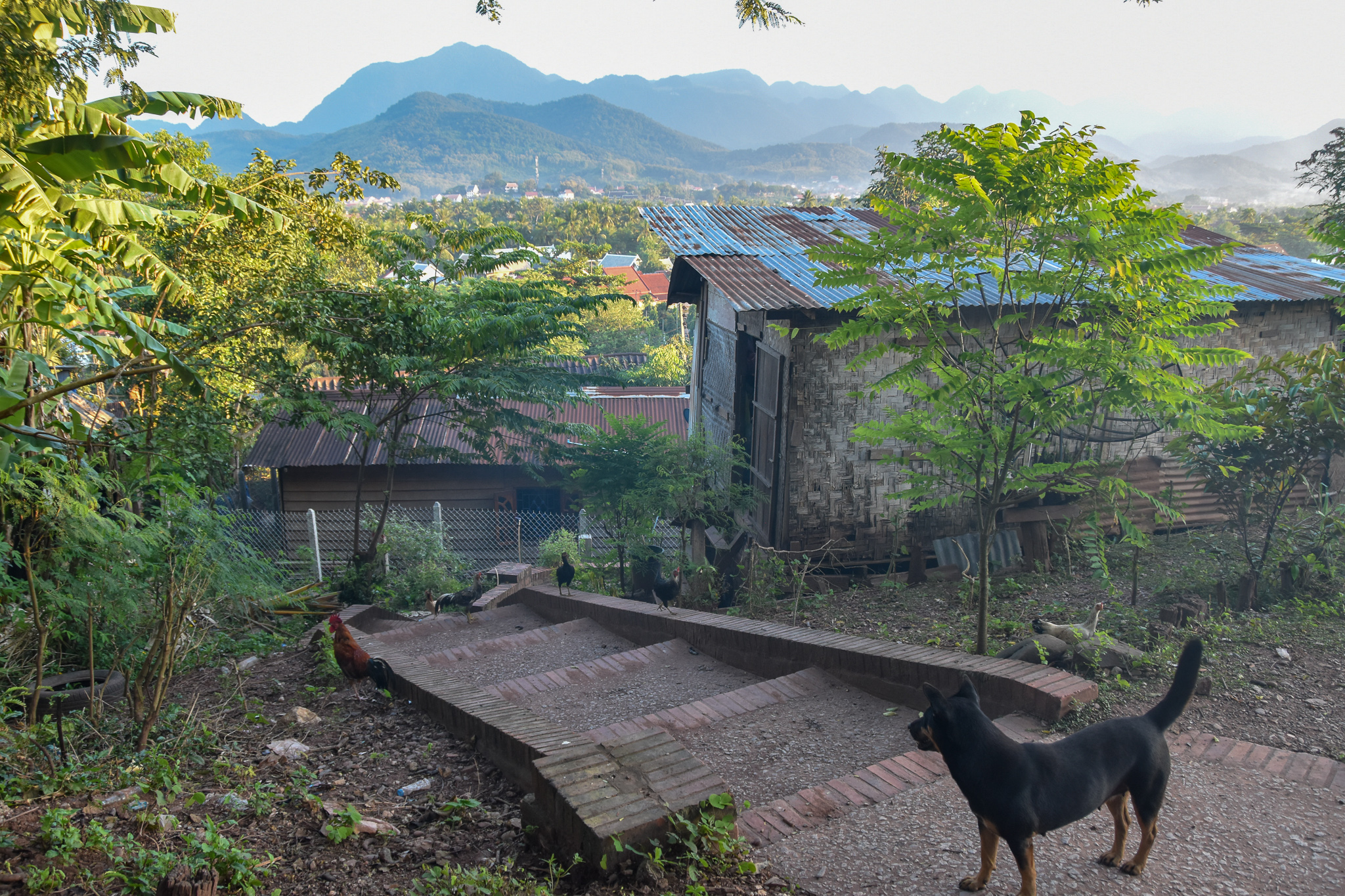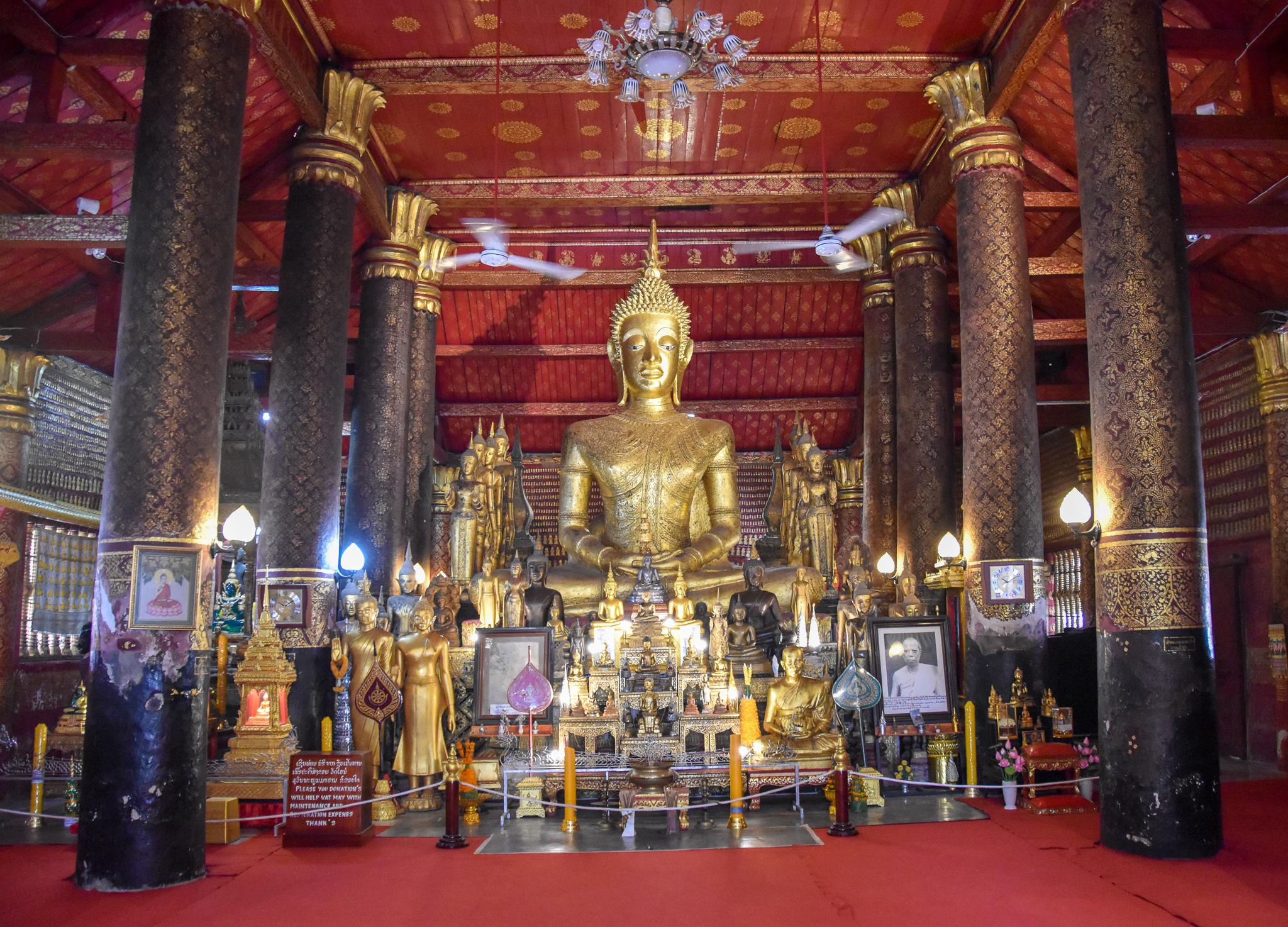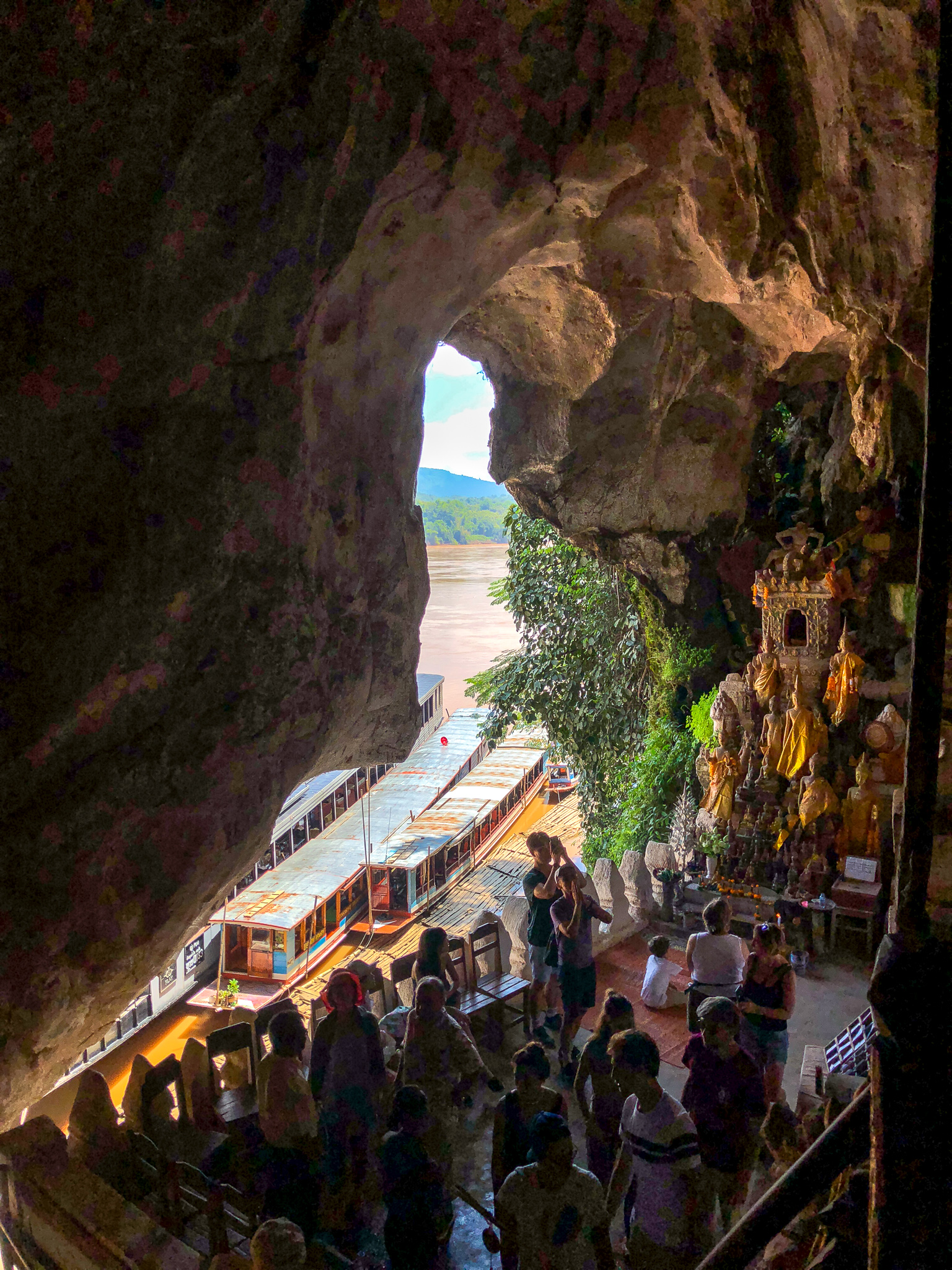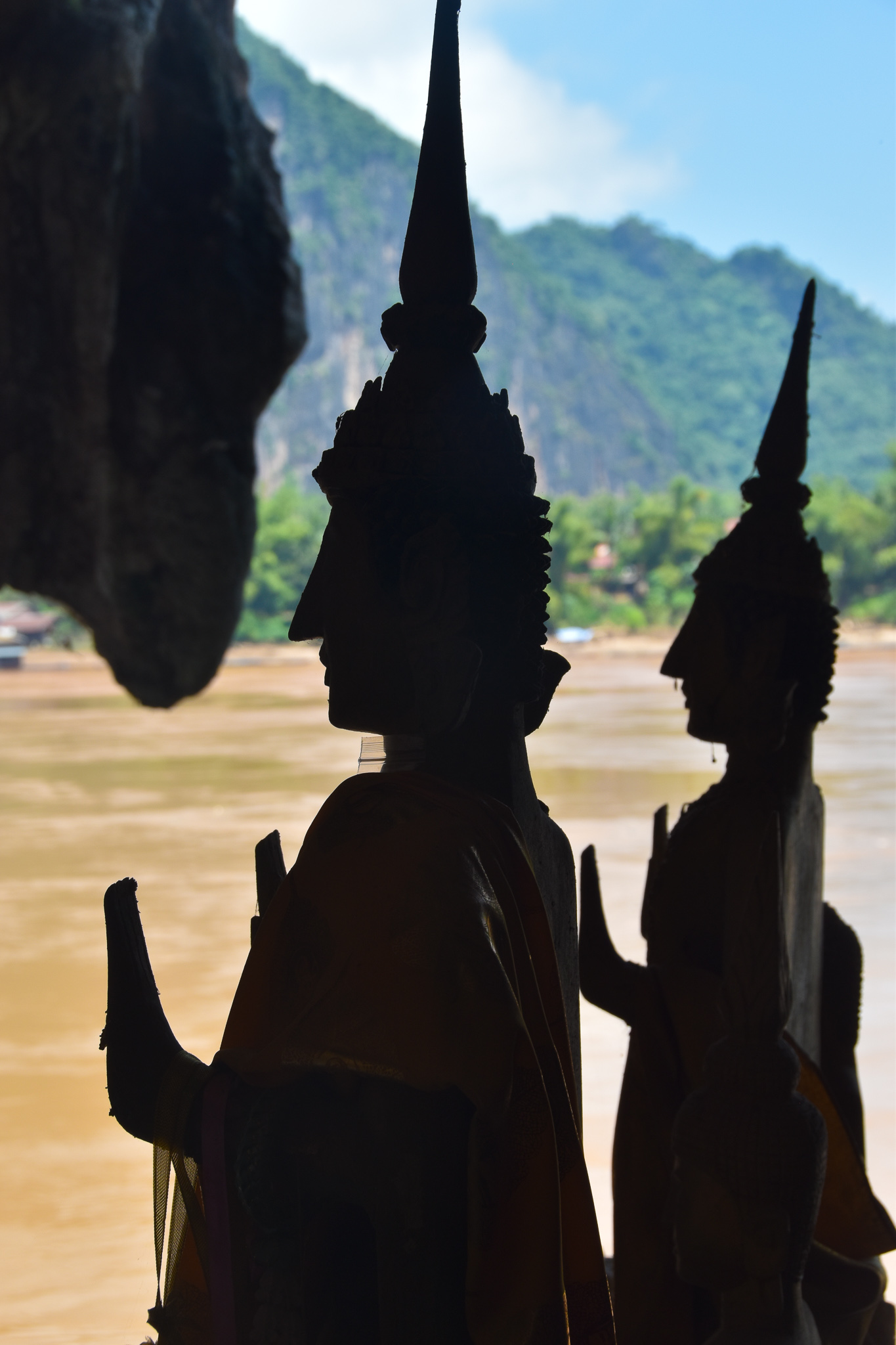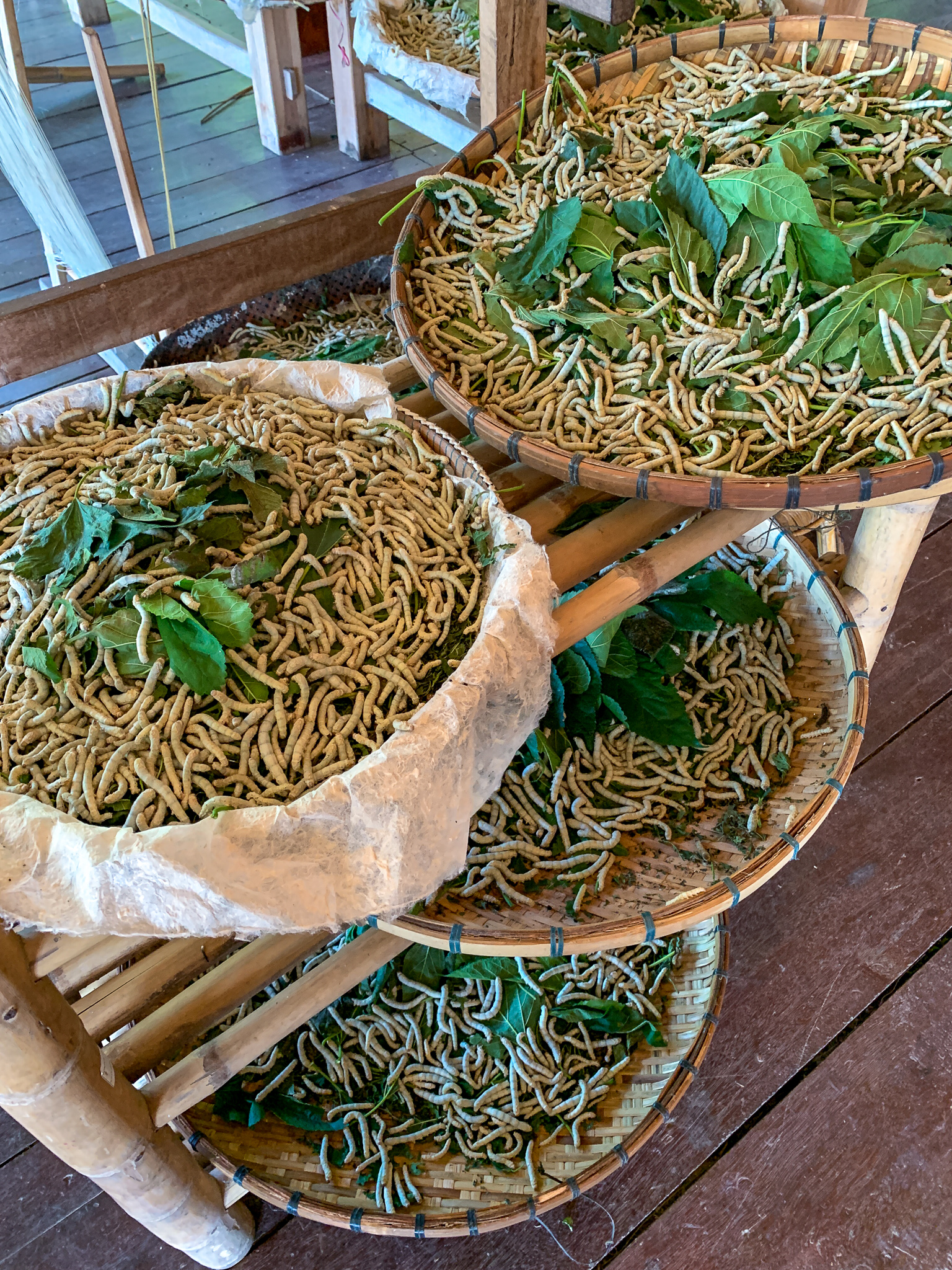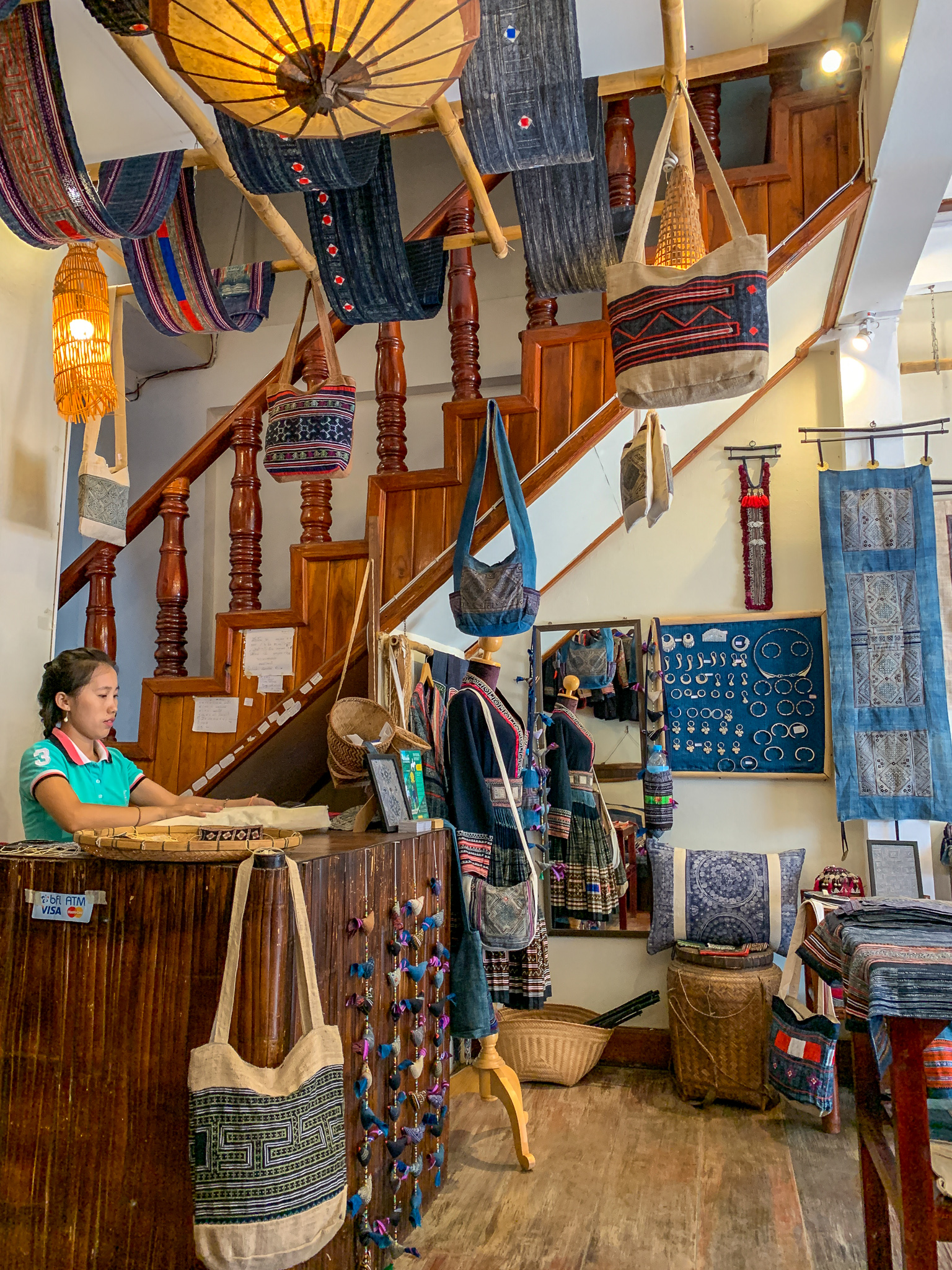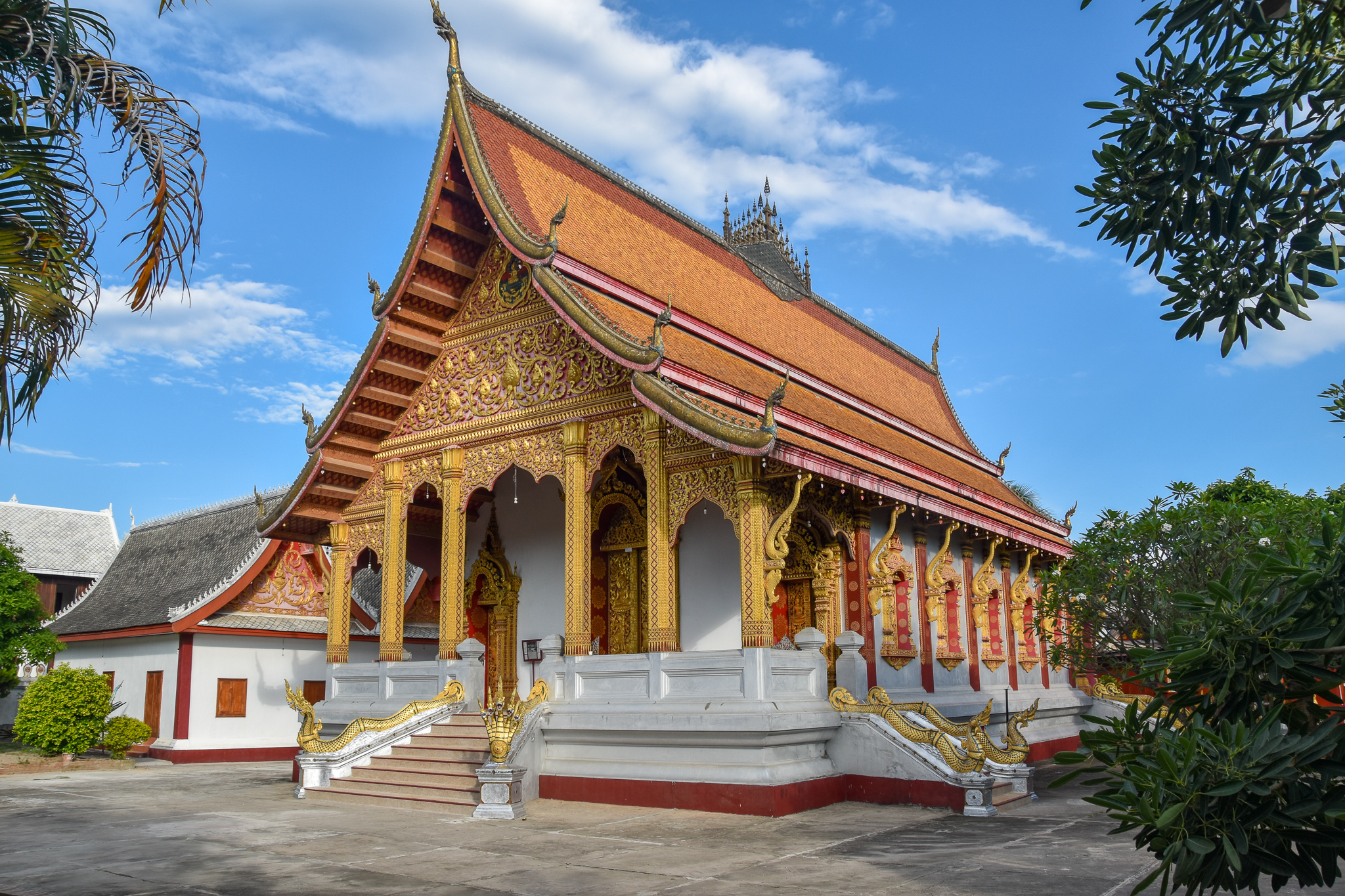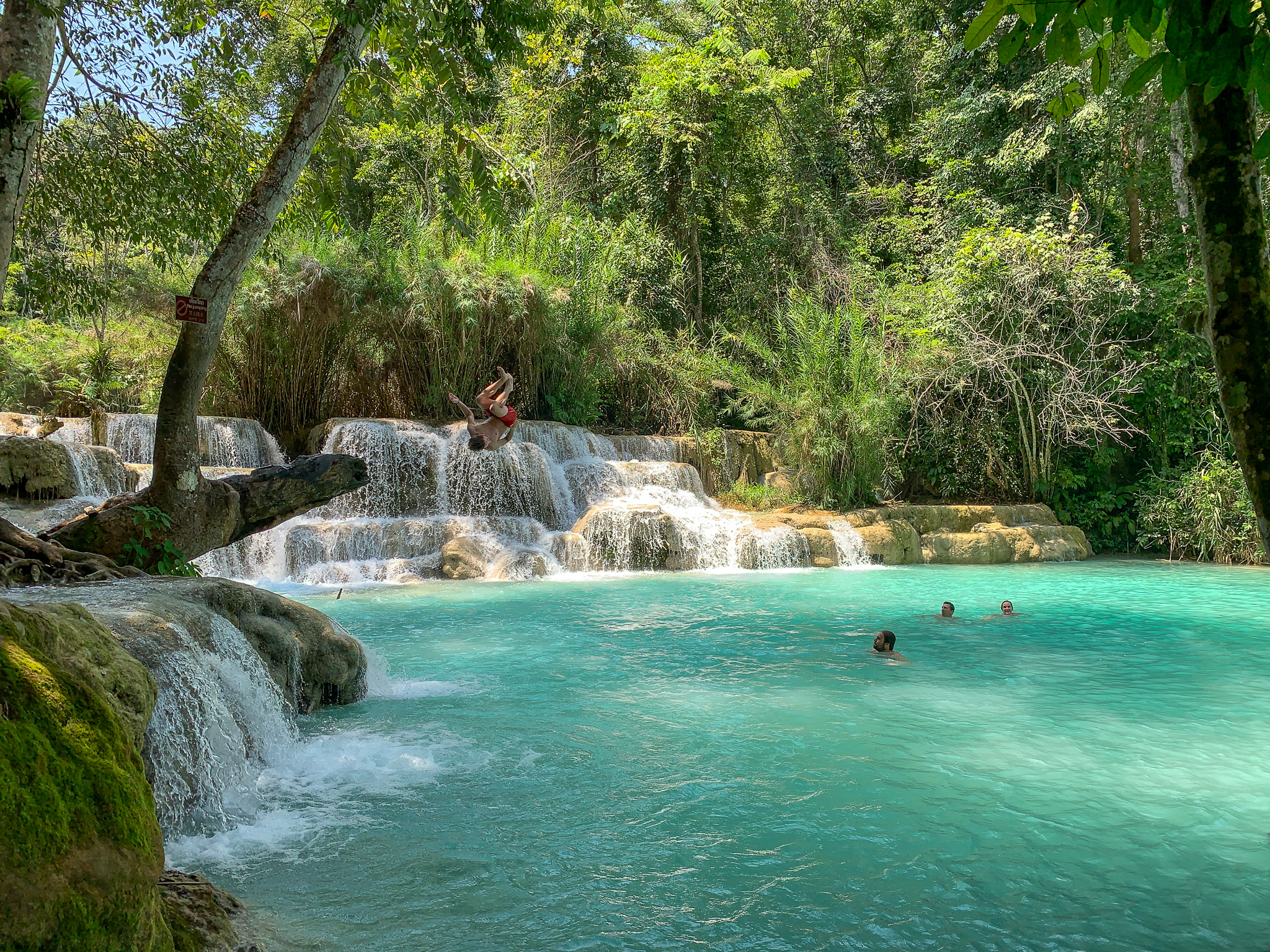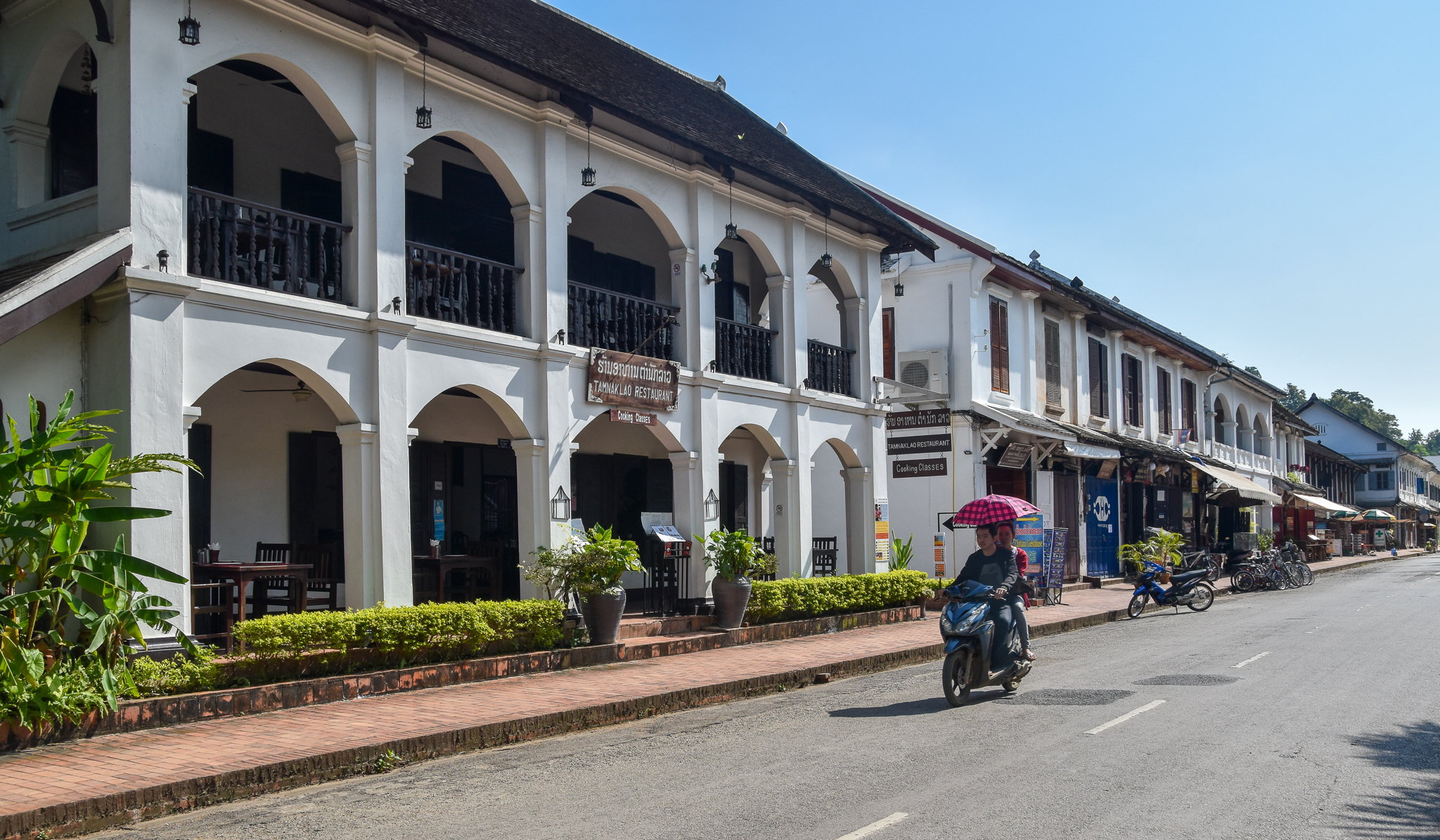Southeast Asia is one of our favorite parts of the world, full of many famous and interesting destinations. Despite several prior trips to the region, Laos was one country we had never had the chance to visit. We decided to take advantage of a trip to Bangkok last year to add a long weekend excursion to Luang Prabang, a small city in the north center of the country.
Founded at the confluence of the Nam Khan and Mekong Rivers, Luang Prabang has long held a place of royal and spiritual importance. A tumultuous history has seen many different dynasties and kingdoms ruling the region from this city. After a devastating attack by bandits in 1887 (destroying many monasteries that were at the core of the city), the ruling kingdom chose to accept French protection. The French allowed the Lao monarchy to continue to rule, but their presence (especially during the rebuilding period of the city) greatly influenced the architecture and food culture found today. The city was recognized as a UNESCO World Heritage site in 1995 due to its unique and well-preserved blend of Lao and colonial architecture.
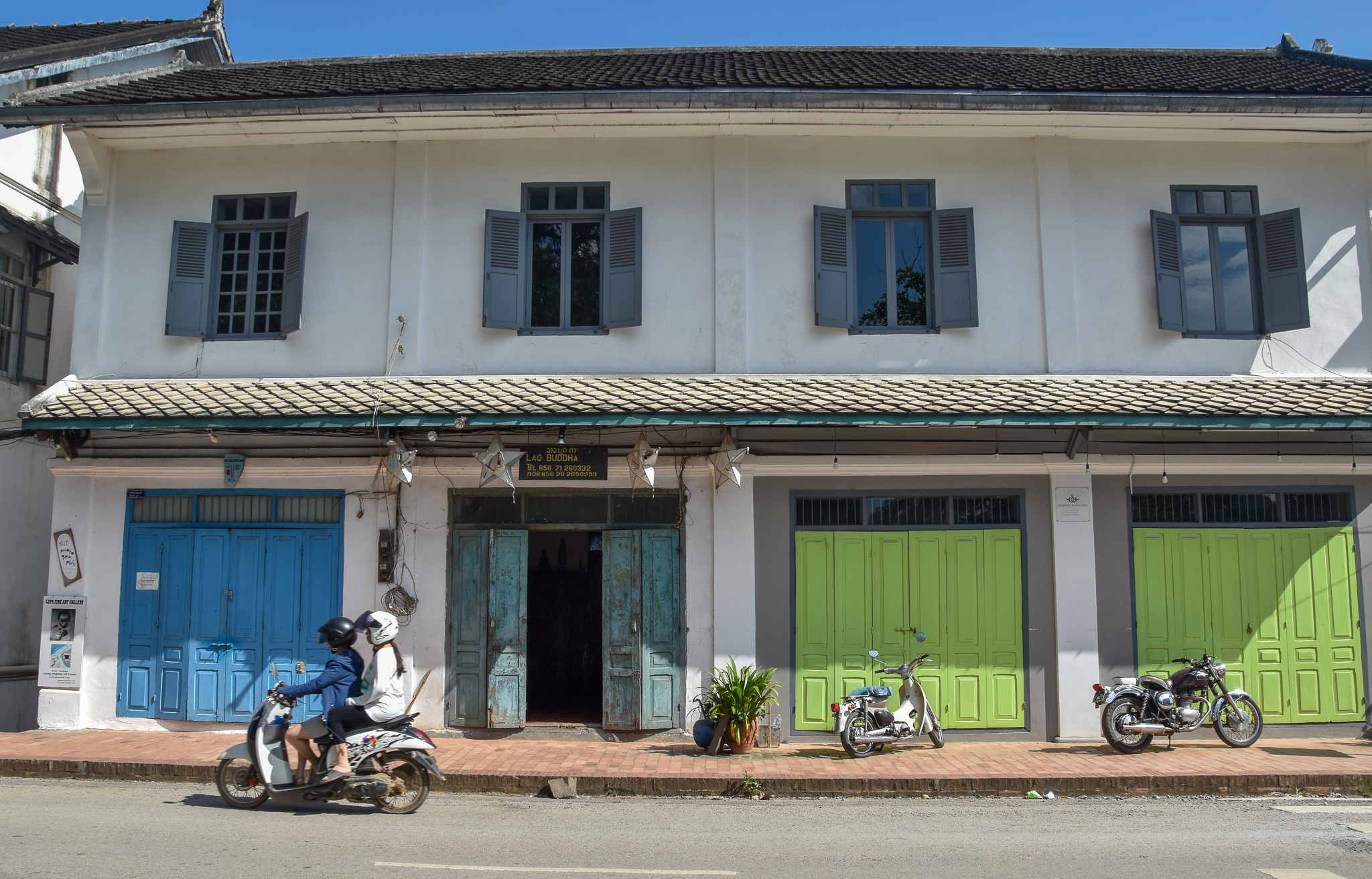
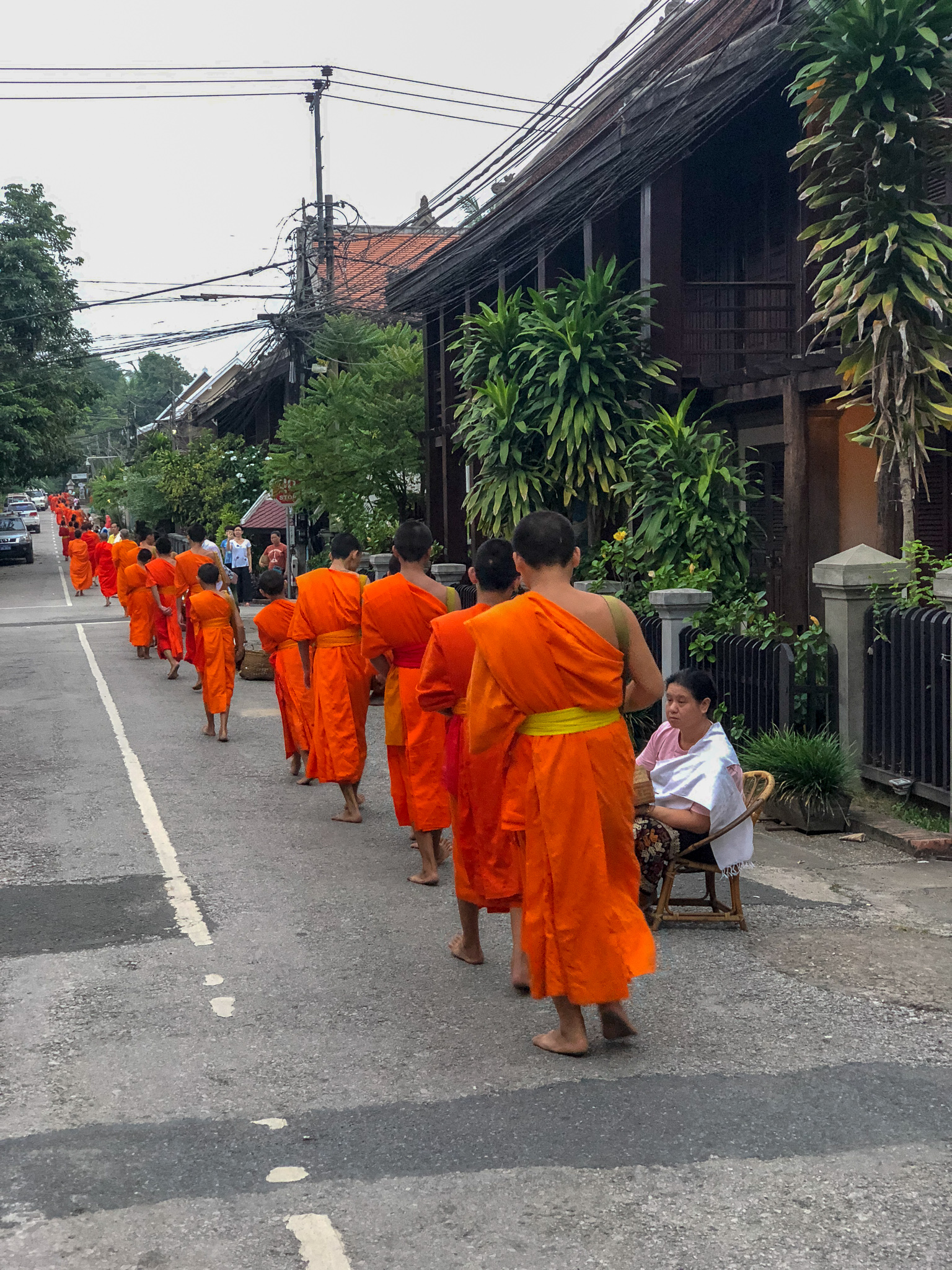

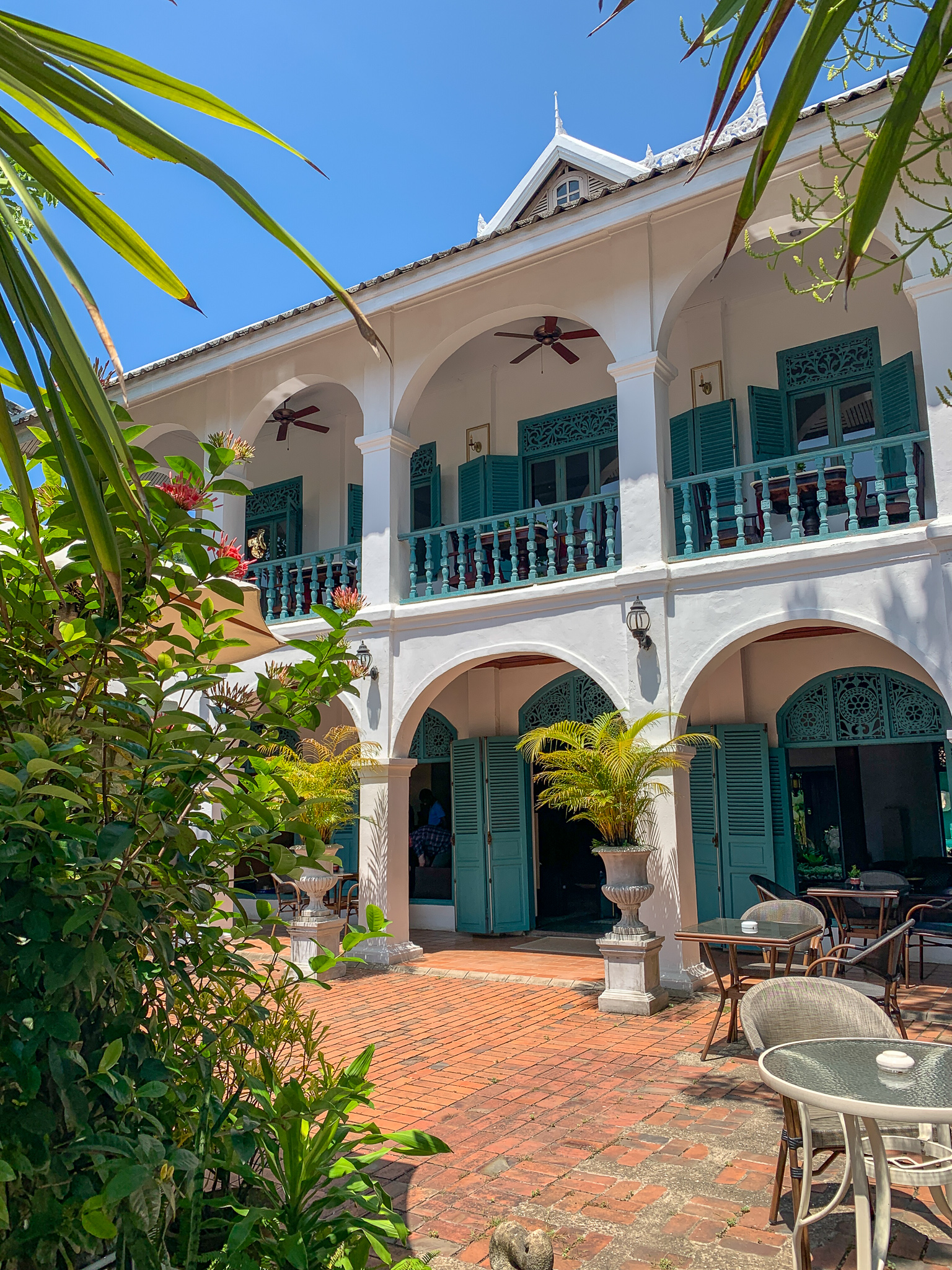

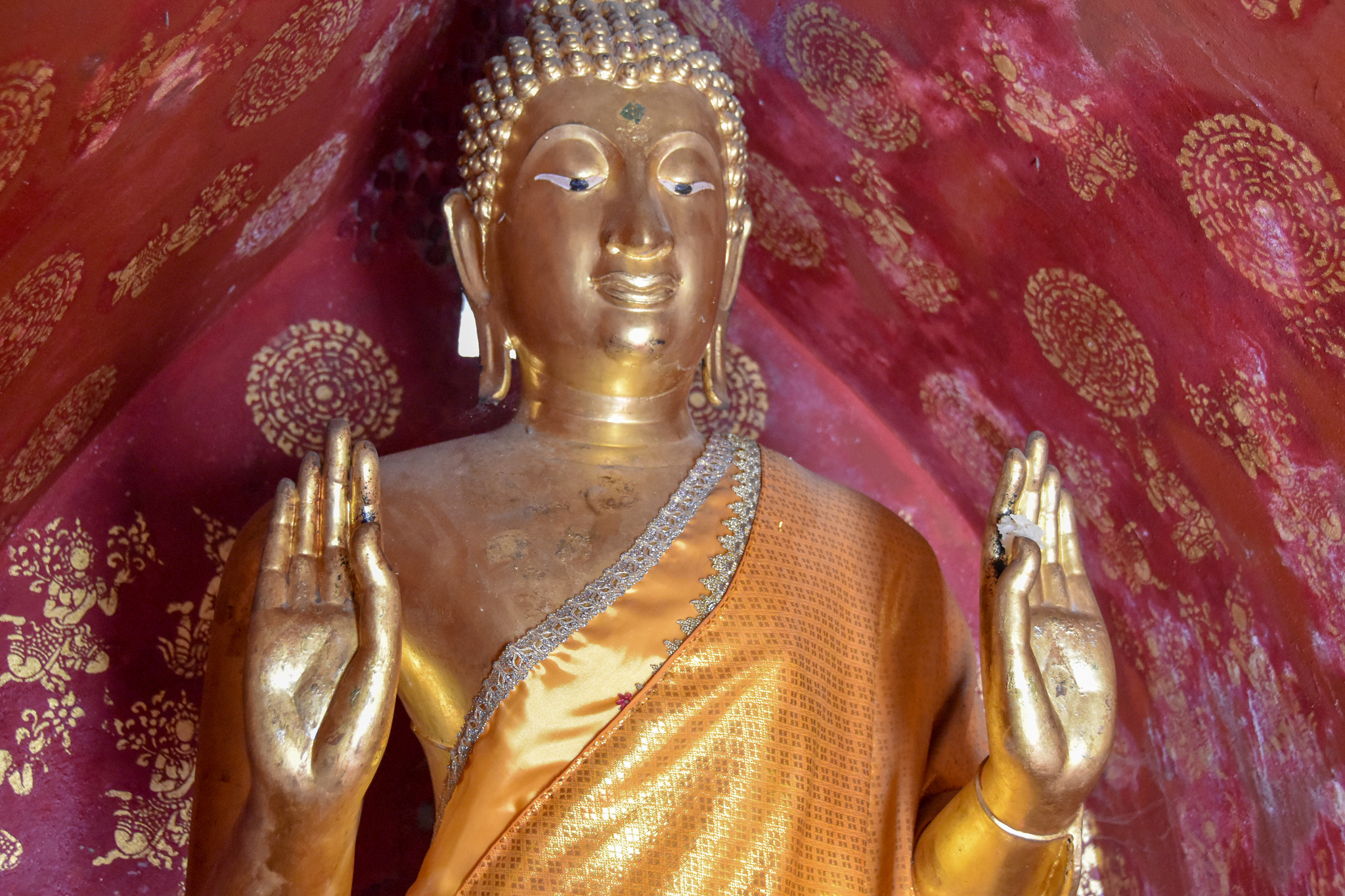
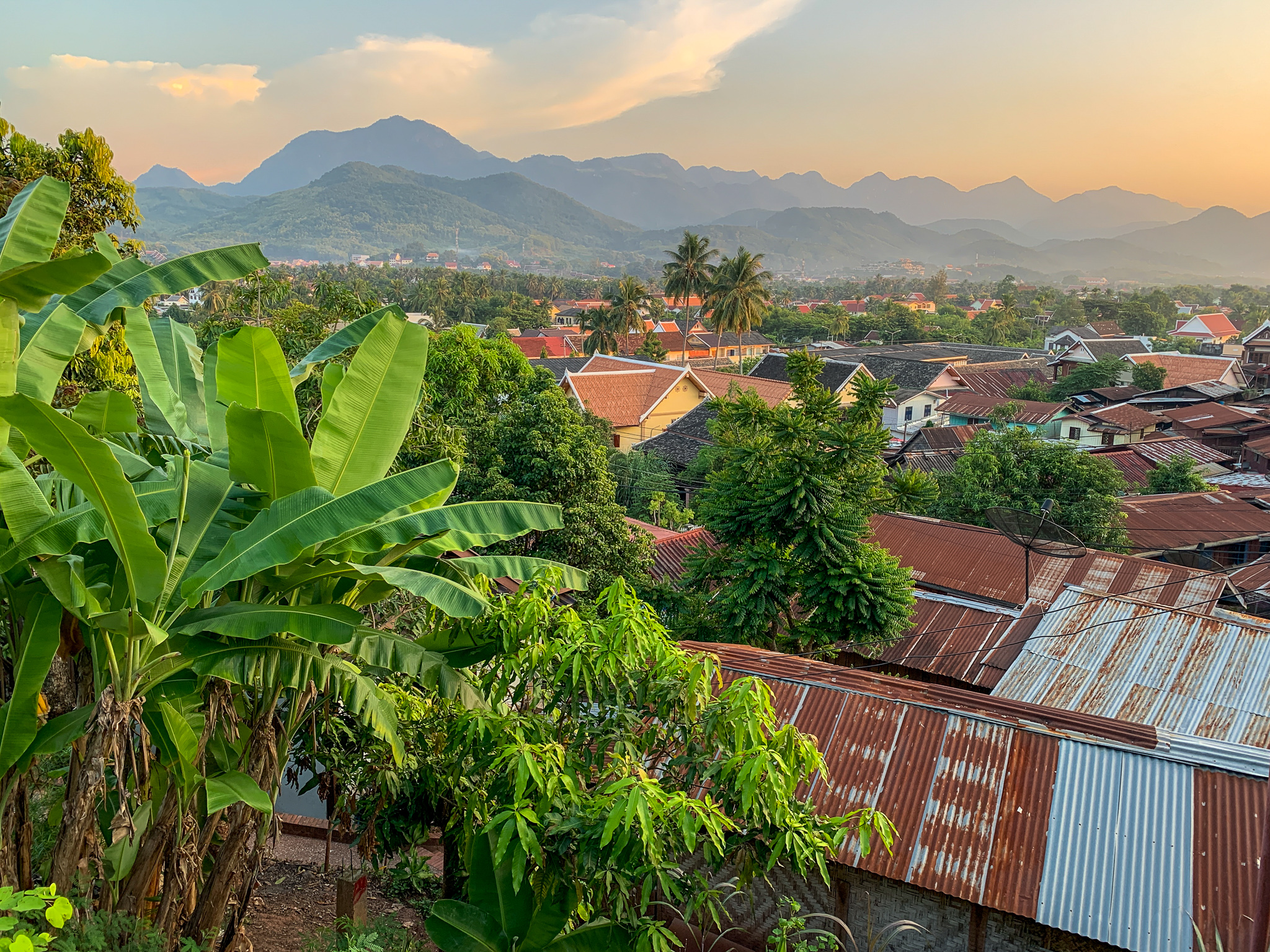
Today the historic part of the city is vibrant with thirty-three Buddhist temples and many restored historic buildings, now housing handicraft shops, restaurants, and guesthouses. The city retains a laid-back feel and is compact, making it easy to go everywhere on foot. Monks in saffron robes are a common site, and it’s easy to while away an afternoon exploring side streets, popping into temples, and watching the rivers flow by.
What To See
One of the highlights of visiting Luang Prabang is observing the daily tak bat, or almsgiving. Hundreds of monks and young novices walk silently through the streets at dawn collecting sticky rice from locals and others there to participate. Those giving the rice believe that they gain spiritual merit through the act of giving. Watching the almsgiving is a magical experience, one that we were happy to wake up for on more than one occasion. We preferred to observe the ceremony from a distance, but there are street vendors that will try to sell you rice so you can participate. From everything we read, it’s best to participate only if it is meaningful to you and especially if you have the ability to prepare your own food donation or insure that what you’re giving is high quality.
We were lucky to be in Luang Prabang in the off-season, but the street around the start of the almsgiving walk (Sakkaline Road) still had a lot quite a few tourists, some of whom were aggressive in trying to capture the right photo. We found that the street the monks return to the temples on (Kounxoau Road) was much quieter and had fewer vendors trying to sell you rice. When we were there in September, the monks were out before 6:00 a.m., but the timing shifts throughout the year with the sunrise.


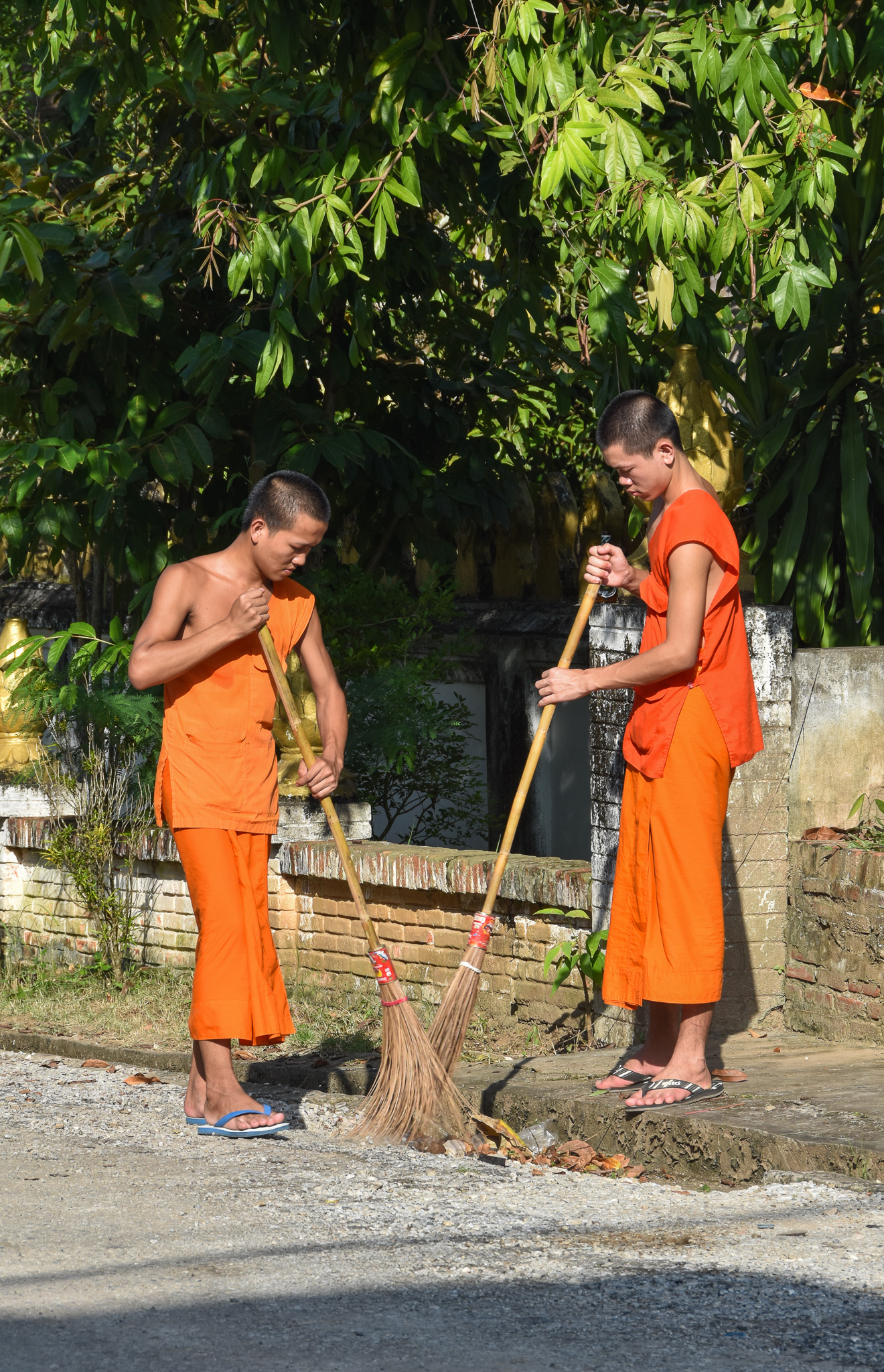




Undoubtedly, the Buddhist temples of Luang Prabang are a highlight. With so many to choose from, we found ourselves stopping into almost every one we passed, but we definitely discovered some highlights. Wat Xieng Thong, one of the few charging a (nominal) entry fee, is absolutely worth the visit. Built in the 16th century, there are several structures on the grounds, including a spectacular ordination hall, and several stupas. The wat was a royal temple until 1975, and Lao kings were crowned there. From Wat Xieng Thong, a walk up Sakkaline Road/Sisavangvong Road brings you past many other wats of all sizes, with some of our favorites being Wat Sensoukharam and Wat Mai.

One of the most beautiful, but newly constructed wats, is on the grounds of the former Royal Palace. Haw Pha Bang was built in 2006 to house the Phra Bang Buddha, the most important Buddha image in Laos. You can only visit the temple with paid entry to the grounds of the Royal Palace Museum. (It’s worth noting that you can get excellent pictures of the temple from the raised terrace across the street from the royal palace entrance.) The royal palace building, built in 1904 after the previous one was destroyed by the bandits in 1887, is well-preserved despite the fact that the communists took the building in 1975 and forced the royal family out. You can tour the family’s private rooms, preserved much as they would have been when they lived there, and see artifacts from their time in power.

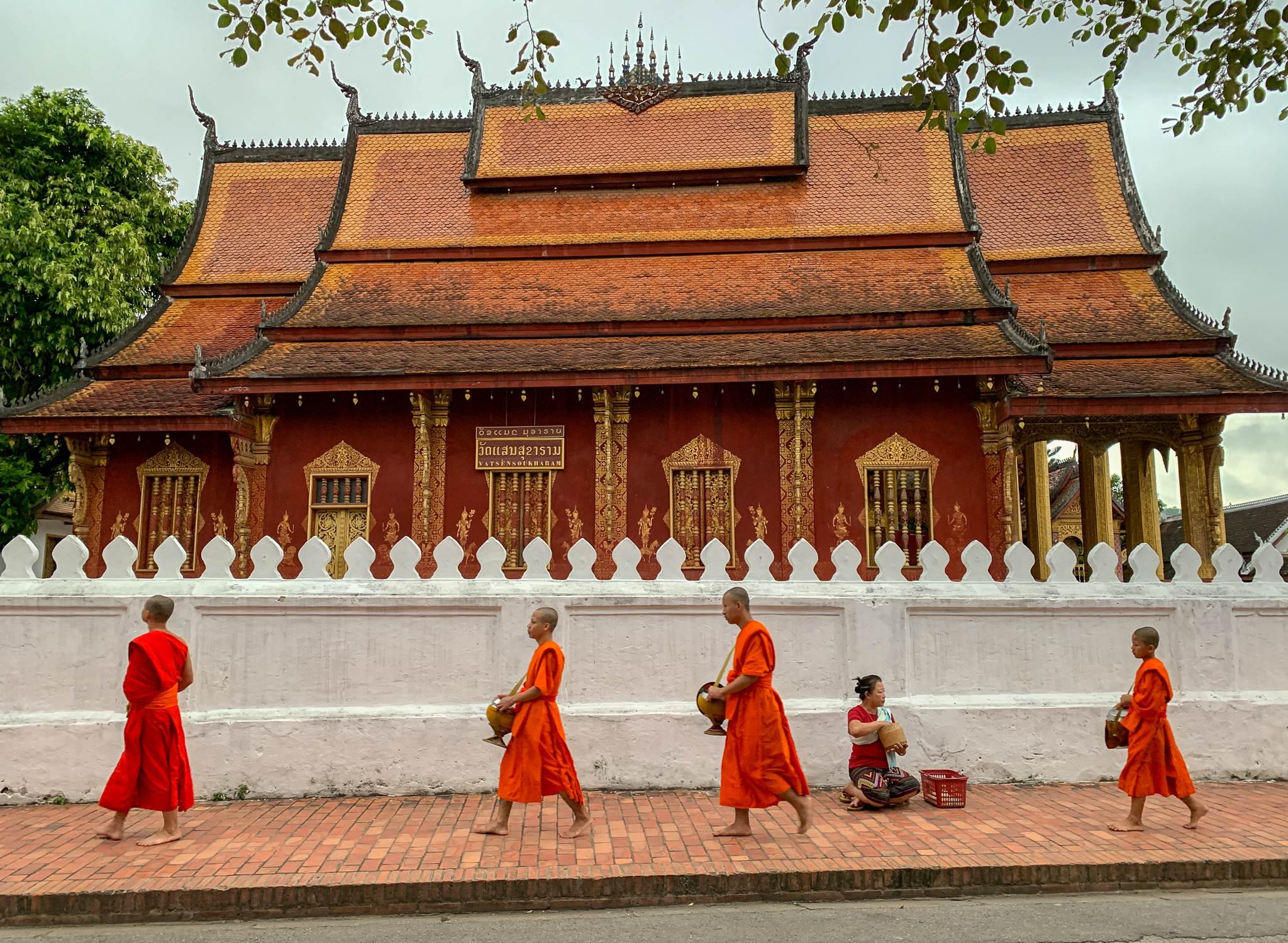



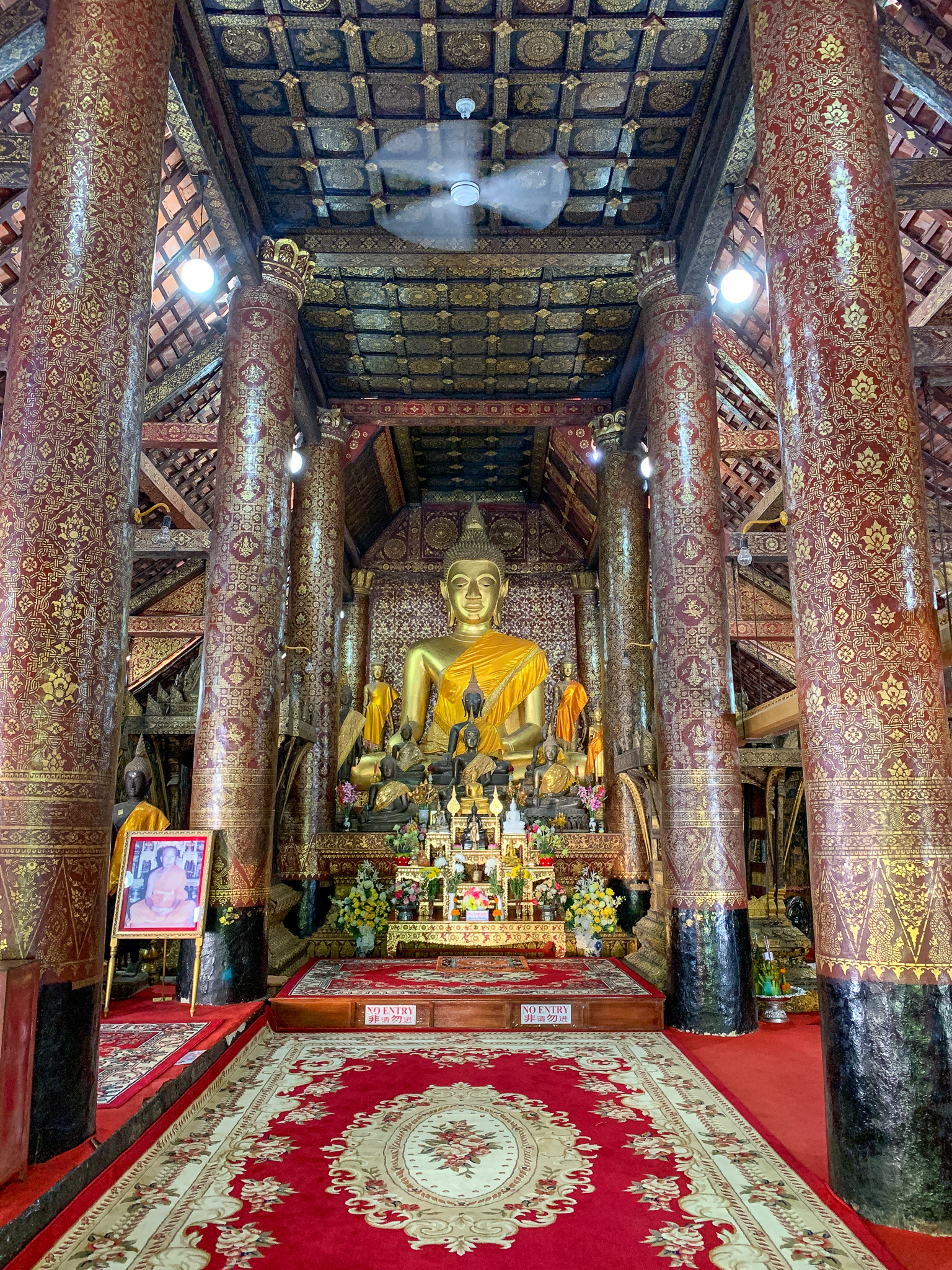
Directly across from the Royal Palace Museum is an entrance to Mount Phousi, the 150m tall hill in the city, dotted with several wats, including Wat Chom Si at the summit. There are several ways to climb the hill, and we chose a path that went behind the Traditional Arts and Ethnology Centre (TAEC) on the southeastern side of the hill. This path brought us through a small neighborhood before we reached the part of the hill where several trails converged and the path turned into steps to the top. Visiting Mount Phousi at sunset is popular, and the views over the Mekong are spectacular—just be ready for some big crowds at the top. Get there early if you can!

We wanted to learn more about the history and culture of the region, so we visited the aforementioned Traditional Arts & Ethnology Centre (TAEC). The centre works to preserve the ethnology and artisanal heritage of Laos through its work with local communities. The museum, located in an old colonial mansion, is small but features informative exhibits including information about the textiles and culture of four main ethnic groups in Laos. The centre also works directly with 20 ethnic groups in 13 provinces to produce handicrafts for their own shops (more information in the “Where to Shop” section below).







On our wanders through the historic city, we spotted the Garavek theater, a small black box space where you can hear traditional stories and music nightly. The duo of performers tells stories in English accompanied by the khene, a handmade bamboo mouth organ. It was a unique experience that allowed us to hear a little bit of local folklore and better understand the local culture.
Despite all the beauty and richness of culture easily evident as soon as one arrives in Laos, we also knew there was a dark period in Lao history during the Vietnam War (known locally as the Second Indochina War). We visited the UXO Laos Information Centre to learn more about this time. Between the years of 1964-72, Laos became a battleground in the war between the United States and North Vietnam, and massive aerial bombing raids took place throughout the country. More ordinance was dropped in Laos during this time than was used in the entirety of World War II, a massive two million tons of explosives. The United States alone flew more than 500,000 bombing runs over the country. Although the initial bombings were devastating, the aftereffects continue to persist to this day. Millions of the bombs dropped failed to explode, and are now found scattered around the country, still a threat particularly in rural communities where they may be struck by farmers or touched by children unaware of what they have found. Twenty-five percent of the communities in Laos report that they have found unexploded ordnance today.



UXO LAO is the national organization responsible for locating and removing unexploded ordnance and helping to educate communities about the risk involved with touching these objects. Each year UXO LAO removes and destroys about 77,000 items of various sizes. The UXO Laos Information Centre is a powerful tribute to the work being done by the organization and provides an enlightening look at the history of the war and lingering effects today. A number of deactivated ordnance are on display, and there’s information in English, as well as movie footage from the time of the war and documentation of the work UXO LAO is doing today. Visits are by donation, and we thought it was well worth our time to learn about this part of Lao history which is still so relevant today.
Excursions
Pak Ou Caves
The Pak Ou Caves are a sacred site consisting of two natural caves filled with thousands of Buddha statues, in various sizes and materials. For centuries locals have been depositing Buddha statues here, many older or slightly damaged and no longer able to be venerated on an altar. The collection of Buddhas is now a site of pilgrimage and tourist attraction.



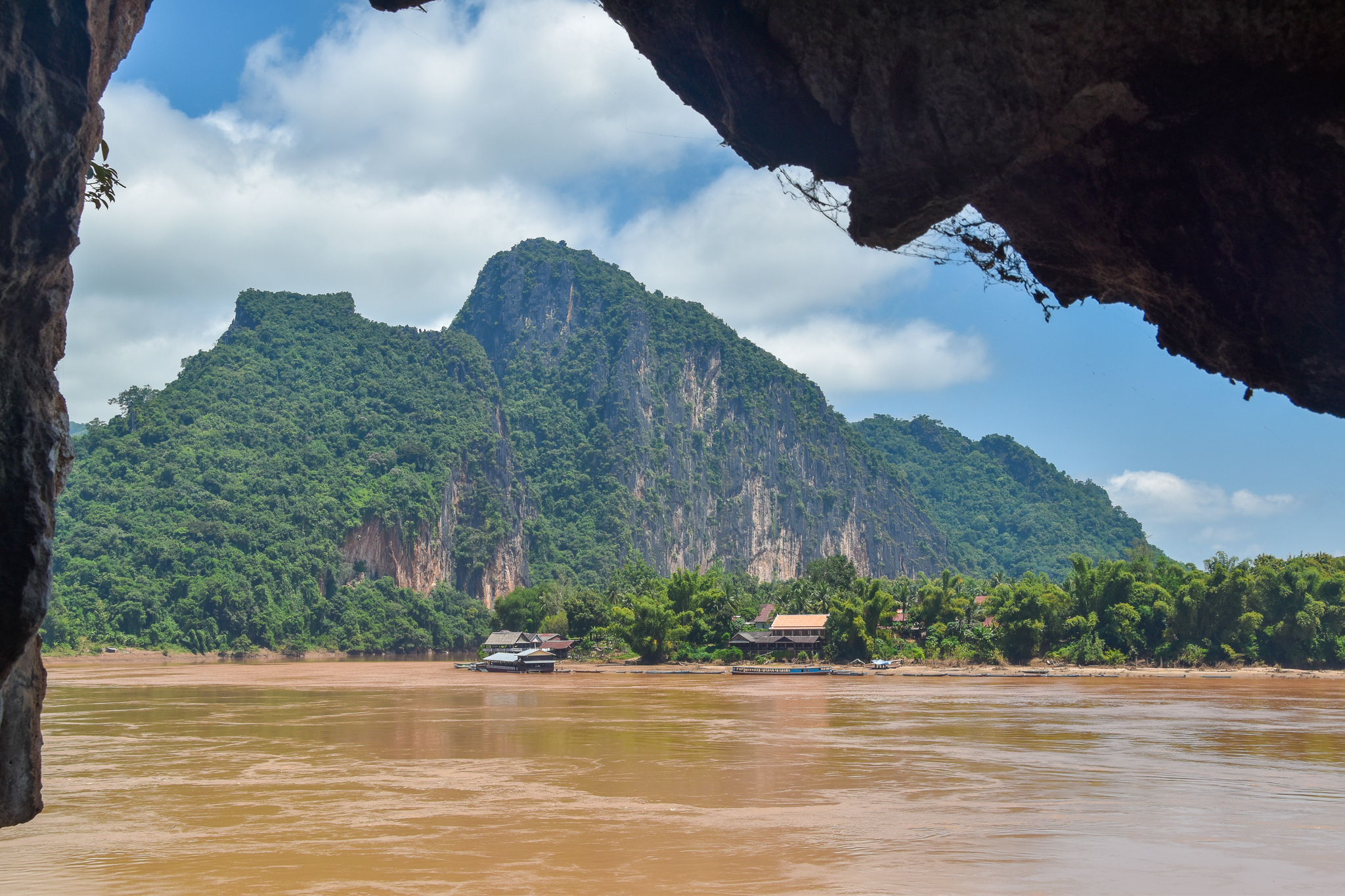
Many tour providers in Luang Prabang offer organized tours to the caves, but we decided we could arrange it ourselves. If you go to the ferry dock on the Mekong River, you can buy a ticket on a boat that goes the 25km upriver to the caves (about a two hour trip). There is no guide included, but purchasing passage for just the boat is a fraction of the cost of going on a full tour. Boats left early in the morning to make the trip there and back in a half day.

Once you arrive at Pak Ou, there are two caves containing Buddha statues—the upper one is reached by a series of steps and is unlit (bring a flashlight). The lower cave has a wide opening allowing in lots of natural light. Entrepreneurial locals charge a modest entry fee to enter both caves.
Most boat tours, and even the boat we took, made a stop halfway between Luang Prabang and the Pak Ou Caves at Ban Xang Hai, the “whisky village.” A market full of goods for tourists has been set up right by the boat dock, including stalls producing and selling the famous Lao rice whisky. Samples are proffered on visitors, and you can purchase whisky to take with you—some bottles even come with snakes or scorpions in the bottle! (No thank you.)
Kuang Si Falls
Kuang Si Falls are arguably one of the most beautiful waterfalls in Southeast Asia. Located 29km (18 miles) from Luang Prabang there is not just a single waterfall, but actually a series of falls set deep in the jungle. The spring-fed falls tumble over levels of travertine limestone, giving it a milky blue color. It was a location that was even more beautiful in real life than in photos.
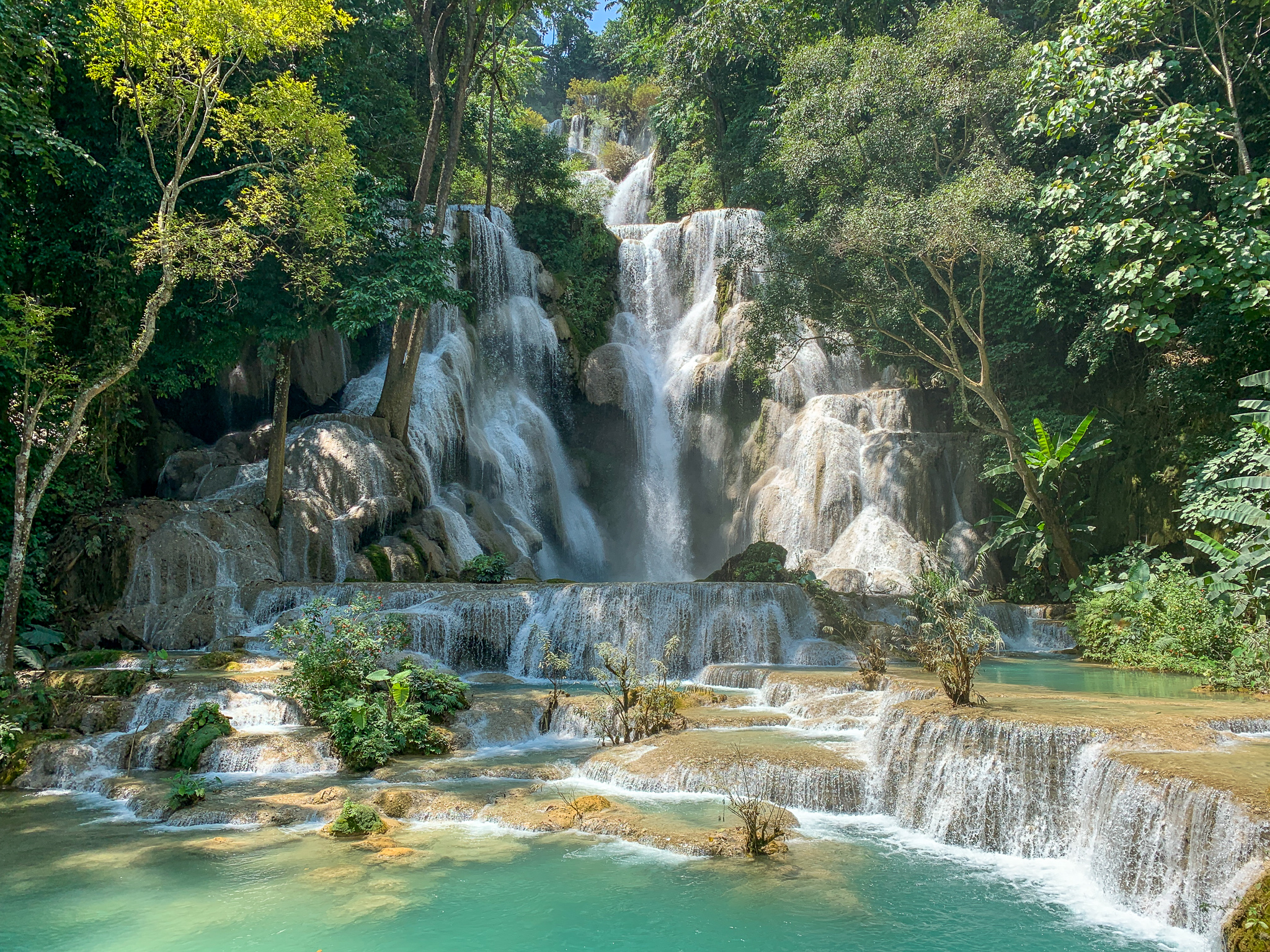
There’s a small entrance fee to gain access to the falls, and there are well maintained trails, as well as picnic tables and changing rooms. There are a few small restaurants within the falls complex as well. Swimming is allowed at various levels of the falls, while there are a few clearly marked sections where it is not permitted. Lots of visitors combine their swimming excursion with a little hiking as well—we hiked up to the top of the tallest fall (which has a 60m drop), and there were even places to swim above the falls. Hiking trails continue on several kilometers past the top of the falls to the spring that is the source of the river.



Kuang Si is about a 50 minute drive from Luang Prabang, and we hired a tuk tuk to take us there. We were there for several hours but could have stayed longer and will pack a picnic next time we go!
Classes at the Living Craft Center
Laos is known for its traditional textiles and weaving, and Ock Pop Tok, an organization supporting local weavers and keeping traditional arts alive, has a significant footprint in Luang Prabang. Founded in 2000, the organization now has multiple stores in Luang Prabang (see more in the “Where to Shop” section below), as well as a school offering weaving and dying classes, cafes and guest rooms. We signed up for a half-day natural dyes class, and headed out to their Living Craft Center, about ten minutes outside the historic heart of Luang Prabang.
The Living Craft Center is set on the banks of the Mekong and is a hub of activity. We were lucky enough to be the only ones who signed up for our class, so we got lots of personal attention from the knowledgeable instructors. We started with a tour of the property and got to learn more about silkworms, silk production, the materials used in natural dyes, and got to watch the weavers and a batik specialist in action. Once we had chosen colors for our own scarves and napkins, we set to work producing the pigments.
We picked indigo leaves on-site to produce a greenish blue dye, and also chopped sappan wood to produce red and yellow dyes. (Some of the other dyes we used had to be prepared in advance like the blue from indigo leaves which is fermented.) Once the dyes were produced, we chose our designs, prepared the pieces and plunked them in their respective pots of dye for various lengths of time (some dyes were heated over a wood fire, and others, like blue, were in a standing vat). Once they were soaked and stirred for enough time, we were able to rinse and unravel our final products. The class included two cloth napkins and one silk scarf per person, and we were pretty pleased with what we produced! For those who want to learn more about how local textiles are produced, a trip out to the Living Craft Center is well worth it, even if you don’t have time to take a class. The setting is beautiful, and you can tour the grounds and there’s a cafe and shop on-site—free tuk tuk transportation is available from either of Ock Pop Tok’s stores in Luang Prabang.
Where to Eat
Laos has its own distinct food culture, influenced by the food in neighboring regions but using their own local ingredients and flavors. A staple of the Lao diet is sticky rice, either balled up and eaten by hand, dipped into different sauces and main dishes, or served alongside meat or fish. The rice is typically cooked and served in a woven basket called a thip khao. Vegetables like tomatoes and eggplant, which are less common in other cuisines of Southeast Asia, appear often in dishes, as does dill. On several occasions we started our meal with sticky rice and a sampling of dips—in particular jeow mak len, a salsa-like tomato dip and jeow mak keua, a smoky eggplant dish reminiscent of baba ganoush.

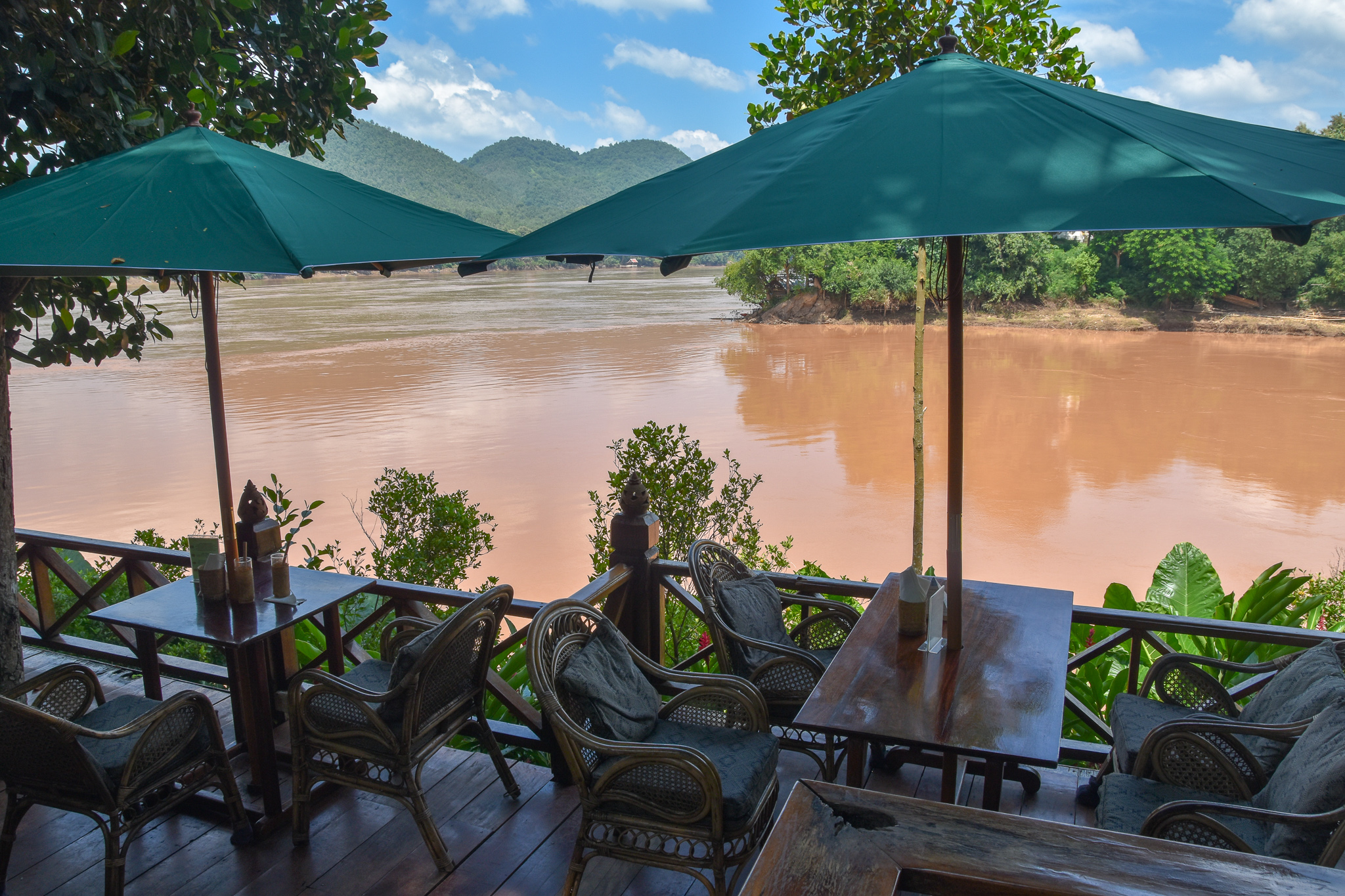


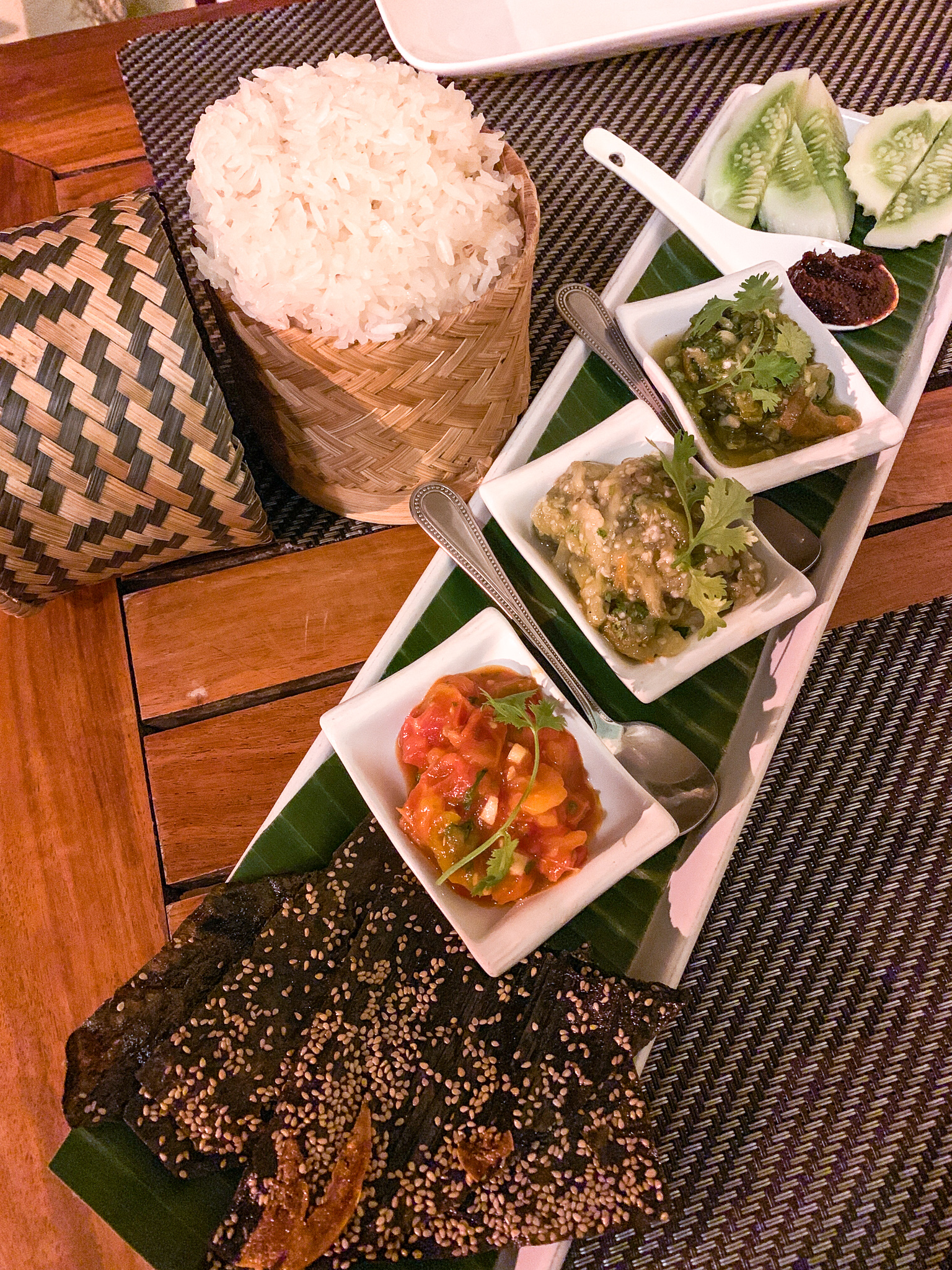

One of our favorite dishes from this region is kaipen, a fried river weed served with sesame seeds and garlic and a spicy chili paste for dipping called jeow bong. The chili paste is often served mixed with strips of water buffalo skin. Laab is a common main dish—a mixture of shredded meat (or tofu or mushrooms for vegetarians) plus vegetables and herbs, typically served with lettuce or other greens to scoop it up. Little pork sausages called sai oua are also commonplace; the Luang Prabang version is usually made with plenty of dill and is especially tasty.
The decades of French colonialism in Laos has also influenced the food culture. Coffee was brought to Laos in the early 20th century by the French, and today Lao-style coffee is widely available. The strong brew is served with a dose of sweetened condensed milk, and can be found in cafes and roadside stands. There are also a multitude of French bakeries, our favorite being Le Banneton, a lovely cafe in a historic building nestled right between some of the city’s temples. They open early, and we loved to grab chocolate croissants after watching the morning tak bat.



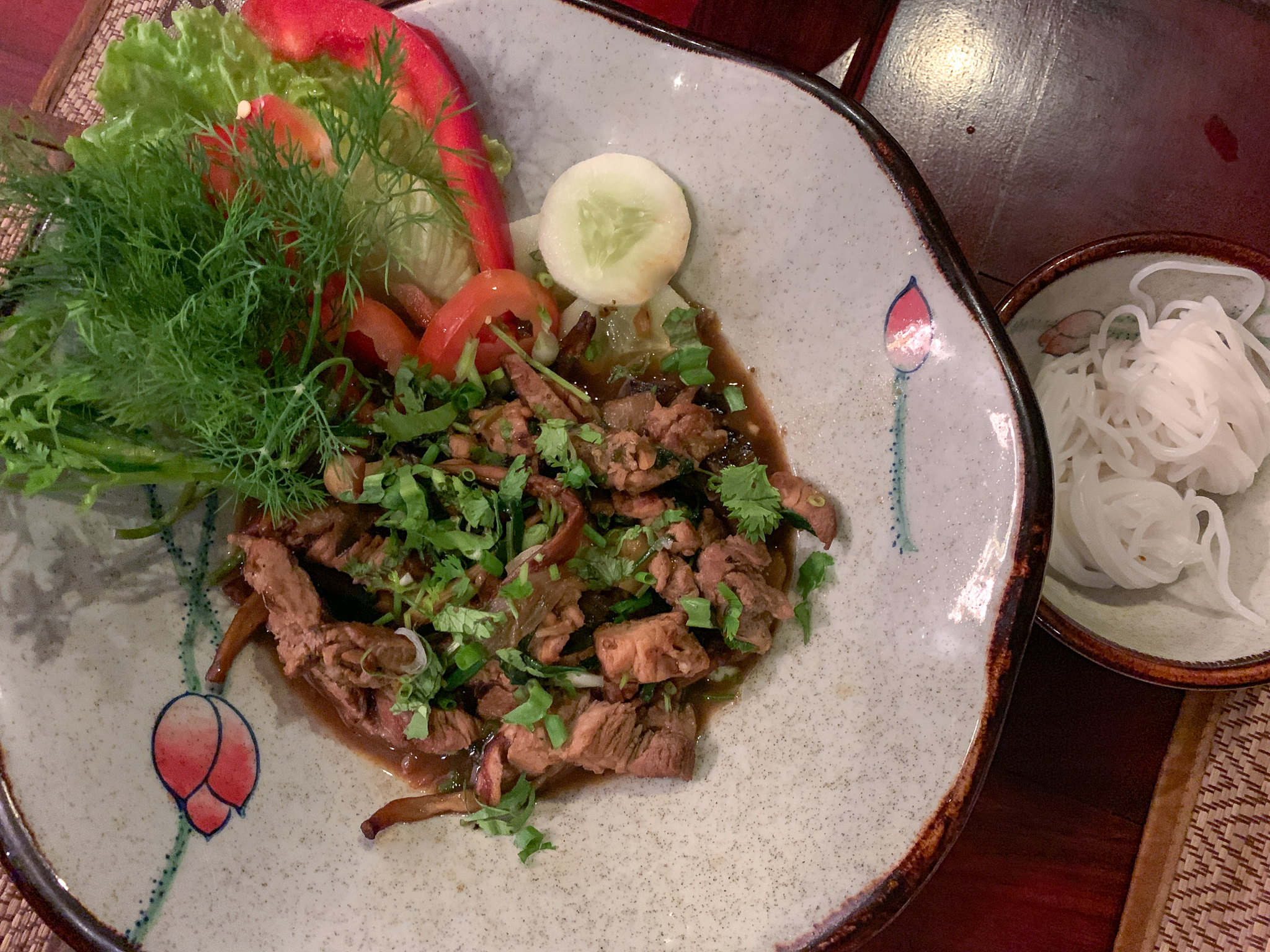

When dining out we were deliberate to seek out places serving authentic Lao cuisine. There’s great interest in preserving and celebrating the food culture of the region, and we had lots of fantastic options. Here are some of our favorites:
- Tamarind is one of the finest places to sample traditional Laotian cooking. Opened in 2005, this long-standing restaurant offers a diverse selection of Lao dishes, as well as tasting menus so you can try a set menu of their recommendations. The staff is helpful with guiding you on how to eat certain dishes, and the menu is full of rich explanations about the history of Lao cuisine. They also run a cooking school.
- Café Toui is another great restaurant option, serving a full range of Laotian dishes in the heart of historic Luang Prabang. We had an excellent meal featuring lots of fantastic fresh produce.
- For a very casual but delicious option, Phonheuang Cafe, near Wat Xieng Thong, is an excellent choice. Located in a more residential neighborhood, the open-air restaurant serves both Lao and Thai dishes at bargain prices.

- Silk Road Cafe, part of the aforementioned Ock Pop Tok, has two locations—one in the city center and one overlooking the river at their Living Craft Center. Both locations have Lao and western specialties on the menu, and offer pleasant respites for relaxing after a day of sightseeing (or touring the Living Craft Center).
- 3 Nagas is our choice for lodging in town (see “Where to Stay” below) and they have a beautiful restaurant in the front courtyard of their main building. Serving a variety of Lao specialties, the shady courtyard makes a nice place to watch the comings and goings on this busy street in Luang Prabang. The location was also once the site of an ice cream shop which served as the official supplier for the Royal Court, and the hotel still honors this tradition today by serving ice cream in local flavors like coconut and taro.
- Khaiphaen, a restaurant named after the famous river weed, serves as a vocational training restaurant for marginalized youth. The wait staff, young men and women from various parts of Laos, learn real-life vocational skills through their work in the restaurant, and 100% of the profits are reinvested into their education and social programming. It was a great experience having a meal here, and the food was delicious too.




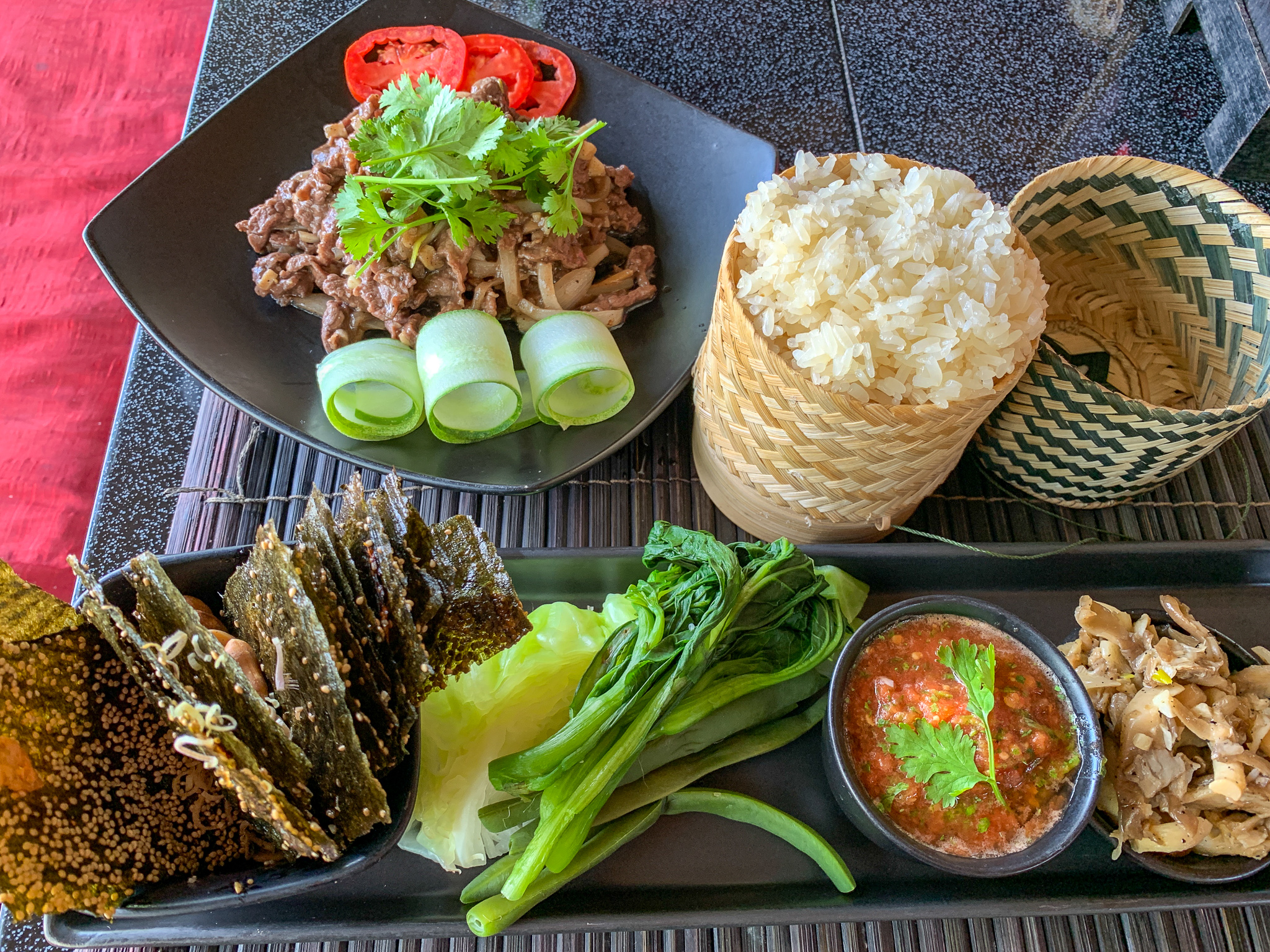
- One of our favorite places for a leisurely lunch is at Dyen Sabai Restaurant, located across the Nam Khan River from historic Luang Prabang. During the dry season a bamboo bridge is set up across the river for access, and in the rainy season the bridge is dismantled and you cross to the restaurant by free boat. The restaurant is set in a series of bamboo huts on the river’s edge offering panoramic views and a relaxed vibe.
- Another option with stellar views it the Viewpoint Restaurant, perched at the end of the peninsula above the confluence of the Nam Khan River and the larger Mekong River. We have not had a chance to go here for a meal, but enjoyed refreshing fruit smoothies with a view after a morning of visiting the nearby temples.
Where to Shop
Luang Prabang has become the hub for the country’s textiles and handicrafts, and there are many fantastic places to shop for traditional and artisanal goods. The streets are lined with shops offering textiles in cotton and silk, antique furniture and decor, food products, and jewelry. A lot of our favorite shops also have a social mission to help improve the lives of local Laotians by providing an outlet for their handicrafts and paying a living wage.
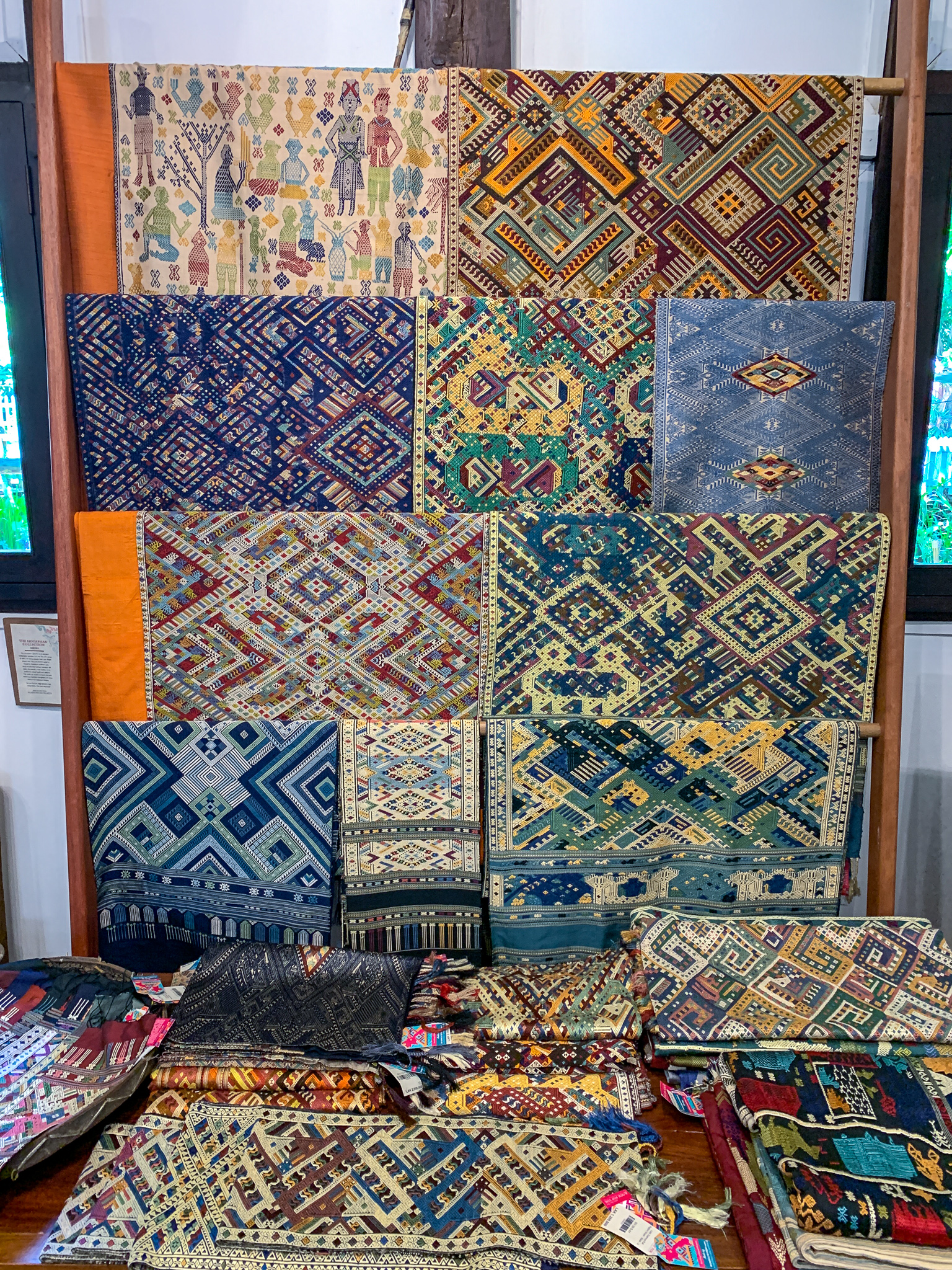

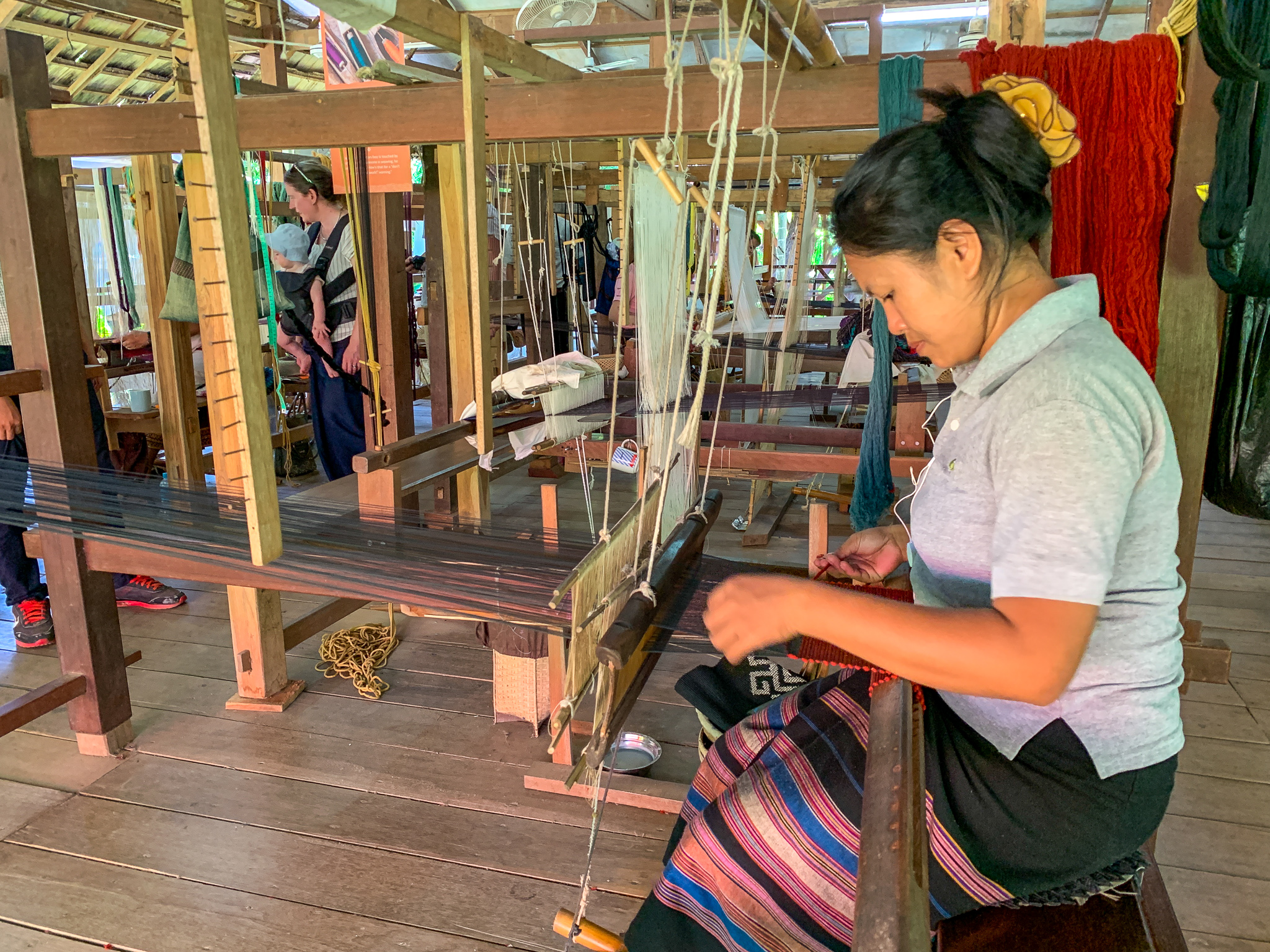


Some of the finest handicrafts can be found at Ock Pop Tok, the organization that offers classes like the natural dyes class we took (see “Excursions” up above). Ock Pop Tok supports weavers in provinces throughout Laos and helps to preserve the traditional crafts of ethnic groups throughout the country. In addition to their Living Craft Center, where we took the class, they have two store locations on the main road of Luang Prabang. The larger Heritage Shop has a more classic range of goods, and offers weaving demonstrations in the front garden. The nearby Boutique has a more contemporary range of goods.
The Traditional Arts & Ethnology Centre (as noted above in the “What to See” section) works with over 20 ethnic groups throughout the country to preserve their cultural heritage and traditions. They have a store in the museum itself as well as a large boutique on the main street in Luang Prabang featuring a great collection of handwoven goods and other artisanal products.
Ma Té Sai, meaning “where is it from?” in the local language, is a store that also sources products from throughout Laos, including not only textiles, but many homewares, food goods, jewelry and clothing. We picked up some organic Lao coffee and tea here, and admired their beautiful scarves, table linens, and other woven goods.
At Passa Paa, a fair trade boutique on the main street, the owners work closely with Hmong communities to take traditional designs and create modern screen prints which are then embellished by local artisans. The store has unique colorful home goods like tea towels, pillows, and bowls, plus a variety of purses and totes.
For beautiful textiles with a history, Hilltribe Heritage collects old and antique pieces of clothing in the rural areas and reworks them into decorations, new clothing, or accessories. They have particularly beautiful indigo and batik pieces, and sell their goods at two different stores in town.
There’s many other wonderful shops that have local goods, and we also made stops in Kopnoi (inside L’Etranger Books & Tea; they not only have handicrafts but a selection of art by local artisans), Celadon (supporting Buddhist education and heritage initiatives), and LaLa Laos (which helps to support the education of students who have moved from the countryside to complete secondary school).
 Like many other Asian cities, Luang Prabang has a vibrant night market that starts around 5:00 p.m. on the road in front of the Royal Palace. You will find the usual assortment of tchotchkes and can bargain with the sellers. The artisanal shops listed above will provide guaranteed quality which obviously comes at a price, but the night market can be a great place to look for less expensive souvenirs.
Like many other Asian cities, Luang Prabang has a vibrant night market that starts around 5:00 p.m. on the road in front of the Royal Palace. You will find the usual assortment of tchotchkes and can bargain with the sellers. The artisanal shops listed above will provide guaranteed quality which obviously comes at a price, but the night market can be a great place to look for less expensive souvenirs.
Where to Stay



We love staying in historic properties, and when we heard about 3 Nagas we knew it would be the perfect home base for our time in Luang Prabang. Situated in three UNESCO-protected historic buildings, the hotel has 15 rooms and is located right on the main road in the heart of the old city. The location made it convenient to return to during the day, and the monks procession for morning almsgiving even goes right in front of the hotel. Guests at 3 Nagas have access to the facilities at the Sofitel in Luang Prabang (another historic property), but we found our days were so full we didn’t have time to explore the sister property.
Getting There and Away
The easiest and most direct way to get to Luang Prabang is to fly into the compact Luang Prabang International Airport, located about 5km from the historic city center. Several airlines fly from various locations in Southeast Asia—we flew a small prop jet on Bangkok Airways from Bangkok’s Suvarnabhumi airport in under two hours. There are also options to arrive overland by bus or by boat on the Mekong River.
A visa is required for citizens of many countries to visit Laos. To obtain a visa on arrival we had to come prepared with two passport photos, a blank page in our passports, and USD 35 plus a USD 1 processing fee (you could also pay in Thai Baht, but the rate was better in USD). The process of obtaining a visa at the airport was very easy and straightforward.
There is an official taxi stand just beyond the baggage claim area at the airport, and we shared a group taxi to our hotel. On the return, we hailed a tuk tuk directly from the hotel to the airport. It’s worth noting that Bangkok Airways offers a lounge in the airport for anyone flying the carrier.
We can’t wait to spend more time exploring Laos, and loved Luang Prabang so much we even went back for a few more days this year. A visit to Luang Prabang makes a great addition if you are already traveling to Bangkok, providing a much slower pace of life than the frenetic energy of Thailand’s largest city.






